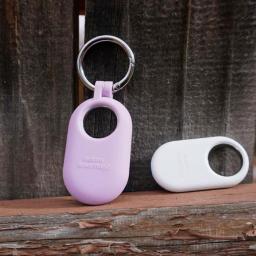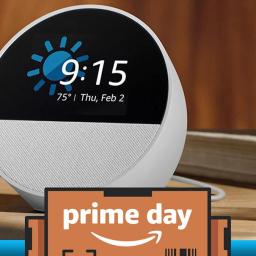 |
by Lawrence Bonk on (#6YJZX)
The latest Amazon Kindle is on sale for $85 as part of Prime Day, but you only have until the end of the day today to pick it up before the sale disappears. This is a discount of $25 and represents a record-low price for the ereader. This is the model that was released in 2024 and the sale includes both colorways. The iconic Kindle easily found a spot on our list of the best ereaders. The entry-level device is not filled with modern bells and whistles, but it gets the job done. It's light and compact, which makes it easy to pack or stow away in a bag, and the battery lasts around six full weeks before requiring a recharge. The 16GB capacity is enough for thousands of books. It also allows access to Kindle Unlimited, which is sort of like Netflix for books. This platform offers the widest selection of any subscription-based reading service, though results will vary depending on the genre. The Kindle is also a good choice for people who like to switch between ebooks and audiobooks. The Whispersync feature keeps everything lined up, so readers can hop back and forth at will. This does require the purchase of both formats, but there's typically a discount. This model does include a backlight, but we found the light to be on the harsher side when compared to some rival ereaders. It's still easier on the eyes than a phone or tablet screen. Like many entry-level Amazon devices, this Kindle shows ads on the lockscreen. However, these are fairly innocuous and mostly promote books.This article originally appeared on Engadget at https://www.engadget.com/deals/prime-days-deal-on-the-latest-amazon-kindle-brings-it-down-to-a-record-low-price-111558051.html?src=rss
|
 Engadget is a web magazine with obsessive daily coverage of everything new in gadgets and consumer electronics
Engadget is a web magazine with obsessive daily coverage of everything new in gadgets and consumer electronics
| Link | https://www.engadget.com/ |
| Feed | https://www.engadget.com/rss.xml |
| Copyright | copyright Yahoo 2025 |
| Updated | 2025-12-10 23:48 |
 |
by Lawrence Bonk on (#6YE1P)
The latest Amazon Kindle Scribe ereader is on sale for just $260 as part of the Prime Day festivities, although you'll have to pick it up today if you want it since the sale ends tonight. This is a record-low price and a discount of $140. The sale applies to the 16GB model, which is enough storage for thousands of books and notes. The Kindle Scribe is Amazon's answer to devices like the reMarkable E ink tablet. It's both a standard ereader and a tablet for taking notes, as it ships with a pen for scribbling. This makes it handy for writing down thoughts or for mindlessly drawing pizza slices. Users can jot notes over books, but not every title supports this feature. The Scribe made our list of the best E Ink tablets for a number of reasons. We appreciated the low latency when writing. In most cases, users won't notice any latency at all. The latest software update also brings in new brush types, which now include a fountain pen, a marker and a pencil. This device makes it easy to create multiple notebooks for different purposes. There are even some AI tools for summarization and the like. Of course, it's also a standard ereader. I have a Scribe and, to be honest, I use it primarily for reading. The giant 10.2-inch screen is just so luxe and offers a superior reading experience to standard-sized Kindles. It's a bit heavier and cumbersome to hold for long periods, but that tradeoff is worth it to me. The only major downside here is the price. It's tough to recommend a $400 ereader, even with all of the handwriting bells and whistles. However, this sale certainly takes the edge off a bit.This article originally appeared on Engadget at https://www.engadget.com/deals/amazon-prime-day-includes-the-latest-kindle-scribe-on-sale-for-a-record-low-price-131544796.html?src=rss
|
 |
by Sarah Fielding on (#6Y1N4)
You likely have a million things to take with you when you leave the house each day - phone, wallet, keys and much more. Keeping track of it all can be tough, but a Bluetooth tracker can help by monitoring the location of at least a few of your most important items. Right now, one of our favorites is still on sale for a record-low price thanks to Amazon Prime Day. The Samsung Galaxy SmartTag 2 is down to just $15.50 a pop on Amazon, a 48-percent discount from its standard price. The main catch here is that only the white option has this steep of a discount. If you want more than one, consider the four-pack option that's on sale for $62. The Samsung Galaxy SmartTag 2 is a solid purchase due to features like being IP67-rated water- and dust-resistant, a sizeable keychain hoop and over 16 months of battery life. It also emits a ring louder than competitors like the AirTag or Tile. The only snag is that you must have a Samsung device in order to use it. This article originally appeared on Engadget at https://www.engadget.com/deals/samsung-smarttag-2-trackers-are-still-available-for-48-percent-off-for-prime-day-130753933.html?src=rss
|
 |
by Andre Revilla on (#6YFMD)
It's Amazon Prime Day again, and we're approaching the end of the four-day affair. There remain an overwhelming number of deals and discounts to sift through, but this steep sale on Apple AirPods Pro 2 is one of the best out there - and it's still available for the last day. These wireless, noise-cancelling headphones are selling for $149. That's a new record-low price, and at a regular price of $249, you're looking at 40 percent off. The Apple AirPods Pro 2 were our overall pick for best wireless earbuds for iPhone, as well as our pick for best overall AirPods. In our hands-on review, we were impressed with the Active Noise Cancelling, as well as the transparency mode for when you're trying to hear the outside world. We found that the audio quality on the 2nd generation of AirPods Pro was an improvement over the first, thanks to a new amplifier, driver and transducer. We also liked that you could seamlessly switch between Apple devices while using them. We do wish the battery life was a bit better, as they offer just six hours of listening per charge with an additional 30 hours provided by the case. In looking at the design of these AirPods, we wouldn't be mad at a bit of an update. I guess if it isn't broke, don't fix it? After all, the design of an AirPod is almost instantly recognizable, so perhaps Apple wants to keep it that way. Far and away our biggest gripe is the price of the Apple AirPods Pro. $249 is a hefty price to pay for a set of earbuds, so we're grateful that sales like Amazon Prime Day provide a great opportunity to snag a pair for far less. If you're looking to spend even less, both models of the AirPods 4 are also on sale for Prime Day. You can get the standard version for $89 or the model with active noise cancellation for $119. This article originally appeared on Engadget at https://www.engadget.com/deals/apples-airpods-pro-2-are-still-on-sale-for-prime-day-and-down-to-a-record-low-price-135116935.html?src=rss
|
 |
by Sarah Fielding on (#6YCJB)
Prime Day is almost over, but the sales are still abundant. There's deals on some of our favorite products, like the TP-Link Deco AXE5400 WI-Fi mesh router system and the Amazon Fire TV Stick 4K Max. In addition, another Amazon device is on sale: the Echo Spot. Currently, you can get the Amazon Echo Spot for $45, down from $80. The 44 percent discount brings the smart alarm clock to a new all-time low. The deal is available on each of the color options, Black, Glacier White and Ocean Blue. Amazon launched the new Echo Spot in 2024, five years after it canned an initial iteration. It's not too different than its predecessor, though its front is split between a screen and a speaker. Amazon also got rid of its camera, which made some people uncomfortable for a bedside table device. Of course, it offers Alexa integration so you can use the voice assistant for everything from getting the time to playing music. That includes controlling smart home devices as well, and you can even pick up the Echo Spot bundled with an Amazon Basics smart light bulb for an extra $5. Elsewhere in the Amazon devices ecosystem, more smart speakers have received discounts. The Echo Pop is 45 percent off and down to $22 for Prime members, and the Echo Show 5 is 33 percent off and down to $60. Neither of those are record-low prices, but they are some of the best discounts we've seen in 2025 so far. This article originally appeared on Engadget at https://www.engadget.com/deals/pick-up-the-amazon-echo-spot-for-45-before-prime-day-ends-133212089.html?src=rss
|
 |
by Ian Carlos Campbell on (#6YBN4)
Amazon Prime Day can be a good time to upgrade your home theater setup thanks to all the tech deals we usually see. As was to be expected, Amazon has discounted nearly all of its own streaming devices, including the Fire TV Stick 4K Max, which is on sale for only $35 right now. That's nearly a record-low price and it represents a 42-percent discount, and today is the last day you can get it at that price. While we still prefer Amazon's Fire TV Stick HD as a budget streaming option, the Fire TV Stick 4K Max could be worth the upgrade for you. Amazon's device supports 4K video, Dolby Atmos, HDR10+ and if you have a newer router, Wi-Fi 6E. It's the best option if you're committed to the dongle-lifestyle - the even-more-powerful Fire TV Cube needs a TV stand to rest on - and a surprisingly great choice if you're looking for a capable retro game console. Amazon's also added in several features to the Fire TV Stick 4K Max that take it beyond a basic streamer. The built-in Ambient Experience lets the dongle display art and widgets when you're not using your TV, not unlike Samsung's The Frame and The Frame Pro. The Fire TV Stick 4K Max can also stream games from Xbox Game Pass using the Xbox app or Amazon Luna. The only real reasons to not consider Amazon's platform is if you don't like using Alexa, which acts as the main voice interface for all Fire TVs, don't want to be pushed towards Amazon's services or your subscriptions are tangled up in another platform. You can buy subscriptions to a variety of streaming services and live channels through Amazon Prime Video, but if you've already done that on Apple TV+ for example, you might want to wait out your subscription before jumping ship. This is just one of a few Fire TV deals you can snag for Prime Day. Others include the Fire TV Cube for $90 and the Fire TV Stick HD for $18. This article originally appeared on Engadget at https://www.engadget.com/deals/prime-day-deal-its-the-last-day-to-get-the-fire-tv-stick-4k-max-for-only-35-122512498.html?src=rss
|
 |
by Anna Washenko on (#6YJNR)
Ghost of Ytei is one of Sony's bigger AAA releases this year, and the company is marking the upcoming launch with gorgeous bundles of its current consoles. There are two versions of the themed bundle, each giving an aesthetic nod to a form of Japanese art. The version inspired by kintsugi shows the artwork of Mt. Ytei in gold, while the black version takes cues from the ink brustwork of Sumi-e. The images have been applied to the disc drive version of the PlayStation 5, and of course also come with a DualSense controller and a digital copy of the game. The controller, which has a stylized portrait of protagonist Atsu on the touchpad that matches the black or gold of the console, can also be purchased separately. The company's also selling the gold version as a cover that existing owners of a PlayStation 5 or a PlayStation 5 Pro. And if our sleuthing is correct, this seems to be the first time Sony's released a cover for the beefier version of the console. The October 2 release date for Ghost of Ytei is when these limited-edition versions will be available. Sony hasn't shared any pricing info and only says that pre-ordering details will come at a later date. But when they are up for pre-order, you'll be able to find all of the items on the PlayStation Store. This article originally appeared on Engadget at https://www.engadget.com/gaming/sony-will-have-gorgeous-playstation-5-bundles-for-ghost-of-yotei-225956104.html?src=rss
|
 |
by Anna Washenko on (#6YJNS)
The scramble to buy the first wave of Nintendo Switch 2 gaming consoles left a lot of fans in the lurch. Getting your hands on a Switch 2 of your own still takes some luck if you weren't fortunate enough to snag a pre-order. One of the points of drama has been that Amazon wasn't stocking the new hardware, reportedly due to Nintendo taking issue with the store's third-party sellers. Until now! The Nintendo Switch 2 + Mario Kart World Bundle is now finally listed for sale there. Before you dash to get the gaming console into your online shopping cart, there is a caveat. Buying the Switch 2 is only available by invitation. You can request an invitation, which appears to be a one-click deal if you're logged in to an Amazon account. The auto-responder email I received didn't offer any details about what might merit me receiving an invite. If you pass muster, though, Amazon will send an invite link that's good for 22 hours.Requests that aren't honored in this round of invites will be eligible for selection in the future, and Amazon explains "you don't need to submit another request for the next three months." So if you're still on the hunt for a Switch 2 and a chance to play the delightful Mario Kart World, it might be worth throwing your name into the Amazon lottery. And while there isn't a Switch 2 Prime Day deal, it has conveniently arrived just as Amazon Prime Day kicks off with plenty of deals and steals from the retailer. Update, July 10, 6PM ET: This story was updated after publish with additional information on the length each invite request is valid for.This article originally appeared on Engadget at https://www.engadget.com/gaming/you-can-finally-buy-the-nintendo-switch-2-on-amazon-but-dont-expect-a-prime-day-deal-195558235.html?src=rss
|
 |
by Andre Revilla on (#6YD9W)
Amazon Prime Day has returned for the summer, making it a good time to check to see if any big-ticket gadgets on your wishlist are on sale. A lot of our favorite tech is on sale at the moment, and that includes a number of Prime Day vacuum deals. One of the best is on the Dyson V15 Detect Plus, which has dropped to $570 for Prime members. We loved the Dyson V15 Detect and it earned a slot in our best cordless vacuums guide. The Plus model on sale during Prime Day is the same vacuum with more accessories. The suction power on the V15 Detect Plus is really impressive, especially for a cordless vacuum. For anyone with pets, good suction should be a strong consideration when selecting a vacuum, and we were thoroughly impressed with the pet hair this model picked up in our tests from both hardwood and carpet. The Fluffy Optic hard surface cleaning head comes with a laser that illuminates the ground in front of you as you vacuum. It does a frighteningly good job of highlighting just how much dust, hair and other debris have collected on your hardwood or tile floors that you might not have seen. For a shocking look at just how much stuff is on your floors, try vacuuming with the lights off. The V15 Detect Plus gets its namesake from a handy LCD display screen on the main body of the vacuum that tells you exactly how many particles across different size ranges the vacuum has detected since you started cleaning. In practice, this doesn't add anything to the functionality of the device, but it sheds a light on just how much stuff you've picked up. Other Prime Day Dyson deals are also available, and they run the gamut from cordless vacuums to headphones to beauty tech. Here are some of the best ones.
|
 |
by Ian Carlos Campbell on (#6YJM7)
Apple, Mastercard and Visa have successfully dodged a lawsuit that claimed the companies were colluding to maintain the current status quo in point-of-sale-payment card services, Reuters reports. The original 2023 lawsuit filed by beverage retailer Mirage Wine and Spirits alleged that Apple was essentially accepting bribes to not develop its open payment network or open up the iPhone's NFC-based "tap to pay" functionality to competitors.The judge on the case ultimately dismissed it over a lack of evidence that Apple ever planned to offer its own payment network. Apple works with both Visa and Mastercard's payment networks to process transactions through Apple Pay. The company's relationship with the two financial services companies extends into its other financial products - the Apple Cash card in Apple Wallet is a Visa and the Apple Card credit card is a Mastercard - and has existed since the start. The New York Times reported in 2014 that Mastercard, Visa and American Express were all part of the original development of Apple Pay.The 2023 lawsuit claims that both Mastercard and Visa were paying Apple to maintain that relationship and their own dominance. The iPhone maker was "paid 15 basis points (i.e., 0.15 percent) on the value of all U.S. credit transactions and 0.5 cents ($0.005) on all U.S. debit," according to the lawsuit. Apple's reluctance to open up NFC tap-to-pay to third-party developers was allegedly another way the company maintained Mastercard and Visa's position and allowed them to drive up fees.However those claims were argued, it wasn't enough to convince the judge. He described them as "a slew of circumstantial allegations," according to Reuters, though he was at least open to the lawsuit being amended and refiled in the future.Since 2023, Apple has made at least one significant change to how Apple Pay and NFC payments work. As part of its compliance with the European Union's Digital Markets Act, Apple opened up NFC tap-to-pay transactions to any developer building their own contactless payments system, whether they're in Europe, the US or the UK.This article originally appeared on Engadget at https://www.engadget.com/big-tech/apple-mastercard-and-visas-antitrust-lawsuit-over-payments-has-been-dismissed-215102818.html?src=rss
|
 |
by Cherlynn Low on (#6YJM8)
Amazon's Prime Day is in full swing, and now that two full days have passed, some of us have gotten past our decision paralysis and checked out our online shopping carts. It's no surprise that the Engadget team consists of people who are fans of tech (and non-tech) products, and we also love a good deal. As we've put together roundups and news stories about the best things to buy this week, we've also been tempted by the savings. Here's a list of what several of our team members bought, not only to share our lives with you but to also show you some of the deals we deemed good enough to spend our own money on. (Ed. note: Igor Bonifacic saved a whopping $2 on this guitar tuner, but it was worth it to him. I'll let him explain.) In Canada, the D'Addario tuner I ended up buying is normally a little more expensive at $20 CAD, but I figured there was a chance it would go on sale for Prime Day. So I set up a Camelcamelcamel alert, and on the morning of July 8 I got an email from the website saying it was... $2 off. Not the greatest discount, but hey, in such an expensive hobby, every dollar counts, right? This past spring, I picked up the guitar for the first time in about 15 years. How it happened doesn't matter. What does matter is that now I play everyday, and I've been asking myself why did I ever stop in the first place. I feel more creative, my eyes feel healthier from less screen time and I'm better now than I ever was as a teenager. As I've gotten back into the hobby, I've slowly been buying all the little accessories that can make it easier to maintain your guitar. With Prime Day around the corner, I set my sights on a headstock tuner. These little gadgets weren't around when I first started learning the instrument, but let me tell you they're great. Like the name suggests, you attach one to the headstock of your guitar. It then allows you to tune the instrument by measuring the vibrations produced by the strings. While you could just as easily use an app like GuitarTuna to do the same, clip-on tuners aren't affected by ambient noise, making the entire tuning process fast and easy. Best of all, they're cheap. In the US, you can spend as little as $15 to buy the model I purchased for Prime Day. - Igor Bonifacic, senior reporter Without even trying, I've become a devotee of Apple's Continuity Camera over the last few years. I think with my laptop and monitor setup, it's just always made more sense to use my iPhone as a camera rather than buying some kind of USB-C docking station or giving up another port on my computer. Unfortunately, I also find having my phone within arm's reach while I'm writing to be pretty distracting. Taking advantage of a Prime Day deal on a dedicated webcam this year is my solution. I purchased an off-white Logitech Brio 500, which normally costs $130, but is $50 off for Prime Day through Amazon or Logitech. It's a kind of a long, tube-shaped 1080p webcam, so not the sleekest or best option out there, but it has the basics I need, like a manual shutter and auto-framing, and critically, it matches my Logitech mouse. If, like me, you can't stand the idea of paying over $100 for a webcam, I think it's a pretty appealing option at $80. - Ian Carlos Campbell, contributing writer I recently discovered that as all my gear transitioned to USB-C, I no longer had any compatible thumb drives. Rather than buy an adapter dongle that I would inevitably lose, I figured it would be smart to have a new thumb drive that could handle both USB-C and USB-3. The discount on the SanDisk drive I bought wasn't huge, but Prime Day seemed like a good time to save a few bucks on a practical purchase. - Anna Washenko, contributing reporter Even though it wasn't on sale this week, I pre-ordered a re-issue for the Studio Series version of Blaster from Amazon because he is one of my favorite Transformers of all time. And then I added Soundwave to my shipment because he's another one of my top 10 favorite bots and you can't really have one without the other. And then I found a small deal on Heatwave, so we picked that up too as a way to save a couple bucks on a present for my son's birthday next month. It's a bit weird to say that as an adult I'm still this fascinated by plastic toys, but sometimes it feels like we're living through a golden age for Transformer figures despite the awful movies we've been subjected to over the last decade and a half (aside from Transformers One). As bad as the Bayverse films are, there's still a rich history of shows and toys and I've had a blast diving back into all of that with my kid. - Sam Rutherford, senior reviewer I made a very short, focused list of three things to buy on Prime Day - a Nori Press, a walking pad and the Ms. Rachel Tonie toy for the kids in my life. But when I was looking through our roundup of the best deals this week, the discounted entry-level iPad caught my eye. My dad had been asking me repeatedly for weeks about an iPad for watching videos and movies while him and my mom were traveling, and I wasn't able to give them an answer as I was weighing a lot of concerns. What is the best operating system for them? Do they need something released recently, or could they save some money on an older model? Seeing this current-generation iPad on sale prompted me to just buy it for them. It simplifies things as my dad uses an iPhone and is familiar with iPadOS, and apps like YouTube and Netflix would satisfy their desires to download videos to watch offline. Saving $70 on what is a very solid device felt like a great deal, but more importantly it earned me points with my family. - Cherlynn Low, managing editor What we're still considering As Prime Day goes on till the end of the week, many on the Engadget team are still weighing their decisions. Executive editor John Falcone, for example, hasn't bought Anker's UFO 3-device charger, but says he wishes he did. I'll update this post if he does, because he will save almost 30 percent on it. Not all our purchases have been through Amazon, either. Editor-in-chief Aaron Souppouris is thinking about buying "a weird camera for too much money not on Amazon." It's a full-spectrum conversion camera, and if and when he does make that purchase, we will be sure to shame him here. Finally, senior editor Billy Steele has made arguably the best shopping decision all week, on or off Amazon. He bought "three Happy Meals trying to get the cool toys. I got three of the same toy. :(" Update, July 10 2025, 5:00PM ET: This story has been updated to add a section on what senior reviewer Sam Rutherford bought.This article originally appeared on Engadget at https://www.engadget.com/deals/amazon-prime-day-2025-the-deals-that-the-engadget-team-spent-our-hard-earned-money-on-154509453.html?src=rss
|
 |
by Karissa Bell on (#6YJHD)
Bluesky users in the UK will soon need to verify their age if they want continued access to direct messages and all of the service's content. The company will begin rolling out age verification features later this month in order to comply with a UK law that requires platforms that offer adult content to confirm users' ages, Bluesky said in an update.The company says it will use Epic games' Kids Web Services to conduct age verification checks, and that people will be able to choose between several different methods, including face scans, ID scans or using a credit card. Bluesky ssers in the UK who don't verify their age will no longer be able to access direct messaging or see adult content shared in the app.Bluesky notes that it's making the change in order to comply with the terms of the UK's Online Safety Act, which requires websites and apps that permit adult content to verify the ages of their users. The law, originally passed in 2023, is set to take effect July 25.While the update will only affect Bluesky users in the UK, officials in the US have been pursuing similar measures for years. The US Supreme Court recently upheld a Texas law requiring porn sites to conduct age verification checks on users. Digital rights and privacy advocates in the United States and the UK have long criticized these measures, saying that they erode privacy and create more opportunities for children and adults' data to be misused.This article originally appeared on Engadget at https://www.engadget.com/social-media/bluesky-is-adding-age-verification-features-for-users-in-the-uk-195753332.html?src=rss
|
 |
by Ian Carlos Campbell on (#6YJHE)
A prolific voice actor behind Pokemon's Professor Oak and many other classic animated characters has passed away. James Carter Cathcart, who was best known for his voice acting work in animation and video games, died of throat cancer at 71, Variety reports.The actor, who was frequently credited as "Jimmy Zoppi" and "Carter Cathcart" throughout his career, played a variety of Pokemon's most memorable supporting characters. Alongside Professor Oak, Cathcart voiced his grandson Gary Oak and Team Rocket's Meowth and James across over 700 episodes of the animated series and 15 movies. That includes Pokemon: The First Movie, Cathcart's first feature film credit. His work wasn't exclusive to animation, either. Cathcart also voiced Vector the Crocodile in the game Shadow the Hedgehog, and provided voices for multiple Pokemon that appeared in Super Smash Bros. Brawl.Beyond voice acting, Cathcart was a talented musician and writer. He's credited with writing and adapting multiple English-language versions of Pokemon TV movies. After 25 years in the entertainment industry, Cathcart decided to retire from voice acting in 2023 due to his cancer diagnosis, Kotaku writes. The voice actor was in hospice care in Forest Hills, New York when he died. He's survived by his wife, Martha Jacobi, and a body of work that touches everything from One Piece to candy bar commercials.This article originally appeared on Engadget at https://www.engadget.com/entertainment/tv-movies/professor-oaks-voice-actor-james-carter-cathcart-has-died-192858421.html?src=rss
|
 |
by Steve Dent on (#6YJF8)
Amazon Prime Day is always a good time to buy a camera as it helps make a major purchase far more palatable. If you've been looking to upgrade your current equipment or get one as a gift, there are a large number of stellar deals available. Many of those deals come from the major brands including Sony, Canon, DJI, GoPro and Fujifilm - including some pulled straight from from our most recent camera guide. You may want to peruse that post for more info as you add items to your cart. With all that said, here are the best Prime Day camera deals we could find for day three of the sale.. Best Prime Day camera deals Canon EOS R100 with RT-S18-45mm lens for $549 (15 percent off): Canon's EOS R100 is the only modern mirrorless camera you can get with a kit lens for under $600. It comes with a 24-megapixel APS-C sensor that delivers great picture quality with Canon's pleasing skin tones. Canon EOS R50 with RF-S18-45mm lens for $749 (15 percent off): Canon's 24-megapixel APS-C EOS R50 is great for travel, parties, street photography and more thanks to the portable size and built-in flash. It offers nice image quality with warm, human friendly photos and is capable for creators as well with 4K 30fps supersampled video, with 10-bit and HDR capability. OM System OM-5 for $899 (25 percent off): For creators on a budget, the 20-megapixel, Micro Four Thirds OM-5 from OM System (formerly Olympic) is a great option at this price. It lets you shoot 4K video and 20MP stills at up to 10 fps. The design is nice with a full complement of manual controls, a fully articulating display and 7.5 stops of built-in stabilization. Panasonic Lumix S9 for $1,298 (13 percent off): The S9 may be Panasonic's smallest full-frame camera but it comes with the same 24MP sensor and similar video features to the popular S5 II. To that end, it offers up to 6.2K video, in-body stabilization and reliable autofocus. The key feature though is a special LUT button that lets you easily choose a custom cinematic look designed by professional creators. Canon EOS R6 Mark II for $1,899 (5 percent off): Canon's R6 Mark II offers a great mix of video and photography features. You can now shoot RAW stills at up to 40 fps and video specs are equally solid with sharp full-sensor 4K at up to 60 fps. It comes with in-body stabilization that's great for video and photos and autofocus is quicker and more versatile than ever. Nikon Z6 III for $2,197 (12 percent off): Nikon's Z6 III is the best hybrid mirrorless camera for the money, thanks to the incredible performance of the 24-megapixel partially stacked sensor. You can shoot RAW bursts at up to 20 fps in electronic shutter mode while nailing sharp shots thanks to the much-improved autofocus. On the video side, it supports 6K RAW at up to 60 fps, or 4K 120p. All of that makes it ideal for creators and photographers alike, with the only drawback being the reduced resolution. Sony A7 IV for $2,198 (19 percent off): It beats many rivals with 33 megapixels of resolution rather than 24, with image quality much improved overall. Video is now up to par with rivals with 4K at up to 60p with 10 bit 4:2:2 quality. Autofocus is incredible for both video and stills, and the in-body stabilization does a good job. The biggest drawback is rolling shutter that limits the use of the electronic shutter. Canon EOS R5 Mark II for $3,999 ($300 off): It's company's best camera in years thanks to improvements in areas like autofocus and video. It comes with a high-resolution 45-megapixel stacked sensor, but still lets you shoot blackout-free bursts at up to 30 fps - and most of the shots will be sharp thanks to the updated autofocus with AI tracking. Video is also strong with up to 8K 60p RAW and 4K 120 fps shooting. Best Prime Day action cam and drone deals DJI Osmo Action 4 for $209 (30 percent off): DJI's Osmo Action 4 is a tremendous deal at this price, as you're not giving up much in comparison to the most recent model, the Action 5. It has the same big 1/1.3-inch sensor that delivers excellent video quality, especially in low light. It also features a D-LogM profile to boost dynamic range, DJI's excellent clip-on mount and high-quality 4K 120p video. DJI Osmo Mobile 7P gimbal for $125 (15 percent off): This three-axis gimbal keeps your smartphone video as smooth as can be with DJI's ActiveTrack 7.0, and includes a magnetic snapping mechanism so you can install your mobile device in seconds. The latest feature is native tracking that follows you around, thanks to the included Multifunctional Module. DJI Mini 4K drone for $309 (21 percent off): The Mini 4 weighs less than 249 grams so it doesn't require a permit, but can still shoot 4K video at up to 30 fps or 2.7K at 60 fps with three-axis stabilization. It can fly up to 31 minutes on a charge and has one-tap movements like dronie, helix and panoramic shooting. GoPro Hero 13 Black for $329 (23 percent off): GoPro's Hero 13 Black is now available with a new family of modular lenses called the HB series (ultra-wide, anamorphic and macro), making it far more versatile for action creators. It also has a slightly bigger battery that allows longer capture times, up to 90 minutes for 4K 30fps video. Other specs remain the same, including up to 5.3K at 60fps in 10-bit color, along with the excellent Hypersmooth stabilization. Insta360 X4 for $349 (30 percent): Insta360 simply dominates the 360-degree category, thanks to its ability to capture action at up to 8K 30fps or 5.7K at 60fps - providing more detail when you reframe it to 16:9. At the same time, the Me Mode that produces flat video (with automatic selfie stick removal) has been upgraded from a maximum 2.7K 30fps to 4K 30fps. It also offers solid battery life, waterproofing to 10m and a free editing app. Best Prime Day deals on camera accessories K&F Concept 25L backpack for $50 (17 percent off): A large 25L three-tiered camera bag that can hold multiple cameras, lenses and drones. It has quick side access and features durable materials with a rain cover, making it great for outdoor travel, weddings or vlogging. Lexar 256GB Professional Silver Pro V60 memory card for $51 (32 percent off): An excellent compromise between speed and value with up to 280MB/s read and 160MB/s write speeds. SmallRig 71-inch Camera Tripod with 360 ball head for $56 (20 percent off): Two-in-one tripod monopod with a head that adjusts 360 degrees so you can take photos at any angle horizontally or vertically. Elgato Key Light 2800 lumens for $140 (22 percent off): For presentations or simple studio shoots, you get a silent, low-heat studio light with high output and a 2900-7000K temperature range. It's controllable by WiFi and has an opal glass face for glare-free diffusion. Elgato Prompter for $190 (37 percent off): Whether you're a creator on YouTube or present on Zoom, the Elgato Prompter is an elegant and popular choice thanks to the built-in display that allows you to read scripts while looking at the camera. Support more cameras than ever, even with wide lenses and features an easy setup. Expired deals DJI Neo drone for $159 (20 percent off): The DJI Neo may be an inexpensive, beginner-friendly drone, but has powerful features like subject tracking and quick shots. It can shoot video at up to 4K 30 fps and is quick and maneuverable, though it's also fairly loud. You can also grab one with three batteries and a charger for $229 (21 percent off).This article originally appeared on Engadget at https://www.engadget.com/cameras/the-best-amazon-prime-day-camera-deals-you-can-still-get-right-now-104502326.html?src=rss
|
 |
by Billy Steele on (#6YJF7)
It's nice to see Samsung offer something new for 2025. For the last few years, the company has been updating existing designs for its annual refreshes, especially its most premium soundbar, the Q990. I was pleasantly surprised to see something entirely new when the company debuted the QS700F ($700) at CES. This model doesn't have the immersive sound that its more expensive sibling offers, but there are several handy features, including the ability to adapt to whichever way you place it. For all of its might, the QS700F only beams Dolby Atmos in a 3.1.2-channel speaker configuration. Eight total drivers provide the sound here, significantly less than what blasts the 11.1.4-channel sound on the all-in-one Q990F. But the QS700F costs half as much, and for people who live in smaller spaces or have smaller living rooms, this more affordable, adaptable model will serve you just fine. Design With the QS700F, Samsung nixed the extra angles from the Q990F since there are no side-firing drivers here. This gives the soundbar a simplified, brick-like rectangular shape that's less of a distraction in front of your TV. The QS700F is also shorter when laid horizontally on a table or mantle, which means it doesn't block your TV. Around the sides and back, Samsung opted to use a rigid, circularly perforated speaker grille that wraps the entire surface. Up top, there's a more refined, horizontal cover that gives the soundbar a more sophisticated look. It also means that you'll be getting the speaker's best-looking side when you flip and rotate it to mount it on a wall. While the included wireless subwoofer won't win any design awards, it's a compact unit at just under 10 inches square. To keep the look clean, Samsung put its logo on the side rather than on the front. It also kept the onboard controls simple, which is important since they're prominently displayed if the soundbar is wall mounted. The buttons are basic icons for source, volume and power, colored so they blend in nicely even when they're in plain sight. Around back, you'll find the wired connections: an HDMI input (eARC), one HDMI output and an optical port. Like most soundbars, the QS700F features some LEDs on the front as a visual cue when you're adjusting volume or making other tweaks. However, when you raise or lower the volume, there's a mini light show that's obnoxious. A single blinking LED for each time you press a button would suffice. There's also an LED that blinks when the soundbar is muted, which I also think is a step too much. You might think you can avoid seeing these if you use the soundbar in its other orientation, but I regret to inform you that there's another set of LEDs on the top that appear if the QS700F is wall-mounted. Software and features Billy Steele for Engadget There are a number of features to discuss on the QS700F, but the most important one is called Convertible Fit. The soundbar has an accelerometer inside that detects whether you've placed the speaker flat or if you've mounted it on a wall. It will then automatically adjust which drivers the front- and up-firing channels are coming from. The positioning of the drivers inside ensures that up-firing units are angled correctly and beaming sound out into the room in both positions. Convertible Fit works really well, and I couldn't tell a huge difference in audio quality between the two orientations. It sounded like the center channel (vocals and dialog) was slightly louder in the wall-mount position, but it wasn't too much of a distraction. Other notable tools include wireless Dolby Atmos with compatible TVs and Wi-Fi connectivity powers AirPlay, Chromecast, Spotify Connect, Roon Service and Tidal Connect. Interestingly, the QS700F doesn't work with Samsung's virtual assistant Bixby for voice controls. Instead, you'll employ Google Assistant through Google Home for that purpose. Then there are the handy features that require a Samsung TV, which you'll need to consider since they're major functions of the soundbar. First up is Samsung's Q-Symphony tech, which allows you to use TV speakers in unison with the soundbar. The company says this produces more robust and nuanced sound," and that it can also enhance clarity with certain models of its AI-equipped TVs. As I don't have a Samsung TV, I wasn't able to test this, but I don't see how more speakers could ever be a bad thing. You can only use Samsung's SpaceFit Sound Pro room calibration if you have one of its TVs with a built-in microphone. The QS700F doesn't have a mic for this purpose, so you'll have to settle for the stock tuning if you don't own one of the required displays. You'll also miss out on Active Voice Amplifier Pro as this model doesn't support the more robust dialog adjustment. There is a Voice Enhance Mode on the QS700F, but it's not as powerful. Hoping to use wireless Dolby Atmos? It'll only work with 2022-2025 Samsung TVs - making it yet another company-exclusive feature. One more place the QS700F falls behind Samsung's flagship Q990F soundbar is video passthrough. The latter offers 4K at 120Hz while the QS700F only manages 4K at 60Hz. I realize this won't matter for a lot of people, but for gamers and movie buffs, this will be disappointing. Like other recent Samsung soundbars, the QS700F can be controlled via the SmartThings app. It contains all kinds of presets, settings and other options, including the ability to adjust channel output, fine-tune audio sync and switch inputs. Since most of what you'll do here pertains to audio performance, I'll discuss the app more later. Sound quality Billy Steele for Engadget The QS700F offers 3.1.2-channel audio with support for Dolby Atmos and DTS Virtual:X. Thanks to the up-firing drivers, this is true Atmos sound, unlike on some soundbars that only offer a virtualized version of the immersive audio. Across eight speakers in the soundbar, the QS700F has three main channels and two up-firing channels. And, of course, the 1" in the middle is the wireless subwoofer. Overall, sound from the QS700F is crisp and clear, providing ample detail for movies and music alike. Despite the smaller package, the compact sub still produces plenty of booming bass, so there's lots of thunder for action scenes in Top Gun: Maverick. The soundbar also capably handled all of the directional audio in Formula 1: Drive to Survive. I did notice that the overall sense of immersion wasn't as high as the Sonos Arc Ultra I just moved out to install the QS700F. That's not really surprising, but it did highlight the limits of 3.1.2-channel soundbars. They're good enough for smaller spaces with four right angles, but taller ceilings and irregular rooms really need more channels and rear speakers. In music, vocals are prominent through the center channels, and for some listeners, they may be overly so. You can adjust this in the app, but I didn't mind it. Highs, mids and lows are all appropriately present, with the subwoofer bumping along when a song calls for it. If you're hoping the QS700F can serve as your music setup in addition to boosting TV audio, you'll be well served by the soundbar. And as I already mentioned, it supports a variety of methods for beaming tunes from your phone without having to get off the couch. There are a number of sound modes to help you find the right tuning for your content. Those include Surround, Game Pro, Adaptive, DTS Virtual:X and Standard. I found Adaptive to be best suited for all-around use since it automatically adjusts the audio based on the content being played. And unless you really want to mess around with the settings on a regular basis, Adaptive allows you to set it and forget it" while still letting the QS700F's sonic prowess shine. In the Advanced Sound Settings," there are options for voice and bass enhancement as well as the handy Night Mode that makes low frequencies less boomy when someone in your home is sleeping. There are also settings for Moderate Bass, which delivers deep, rich bass sound," and Virtual that simulates a wider soundstage in the absence of rear speakers. You can clearly hear that the presets and modes all change the audio to some degree when enabled, so their utility will likely depend on when and where you're using the QS700F. The competition Sonos Beam (Gen 2) Devindra Hardawar for Engadget Samsung and Sony both have new 3.1.2-channel Dolby Atmos soundbars for 2025. Of course, Sony's Theater Bar 6 doesn't do the neat orientation trick that the QS700F does, but there is still a number of direct similarities between the two. They both come with a subwoofer in the box and offer various sound modes. Dolby Atmos and DTS:X audio on the Bar 6 is greatly aided by up-firing speakers and Sony's virtual surround sound tech. And like Samsung, there are certain features that require one of the company's TVs - like the AI-powered Voice Zoom 3 dialog boost. At $650, Sony's soundbar won't save you much over the QS700F at full price. Let's not forget about Sonos. The second-gen Beam is the closest thing to the QS700F in the company's lineup, but there are some caveats. The Beam doesn't have up-firing speakers, so the Atmos sound is entirely virtualized, and you can tell the difference. You do get the benefit of TV Audio Swap with the Ace headphones, but you have to contend with the ongoing battle that is Sonos' app overhaul. The newer Beam is cheaper at $499, but adding a subwoofer that you'll most certainly want costs another $429 (Sub Mini) or $700 (Sub 4). That add-on makes this option much pricier than the QS700F. Wrap-up The QS700F is a breath of fresh air in Samsung's home theater lineup, offering something new when it's flagship Q990 model only got a modest refresh. Sure, some of the handiest features require one of the company's TVs, but that's how Samsung and some of the competition have operated for years now. The biggest item you'll miss out on there is room calibration, especially if you plan to use the QS700F in a space with high ceilings or lots of angles. Caveats aside, the best thing about the soundbar is its automatic orientation adjustment. This gives you a second option for installation down the road if your TV and/or its location change before you're ready to upgrade your audio setup. The QS700F is easy on the eyes too, which isn't always the case with these devices. So, in the end, the combination of features, design and audio performance make this soundbar a worthy contender at the top end of the midrange, if you're willing to live with the limitations of Dolby Atmos in 3.1.2.This article originally appeared on Engadget at https://www.engadget.com/home/home-theater/samsung-hw-qs700f-soundbar-review-sophisticated-design-automatic-adjustments-180035549.html?src=rss
|
 |
by Valentina Palladino on (#6YJF9)
Prime Day is basically Black Friday for Amazon's own devices. For almost as long as the shopping event has taken place (it started in July 2015, if you forgot), it's been one of the most reliable days of the year to snag Amazon gadgets like Kindles Echo speakers and Fire tablets at dirt-cheap prices. Amazon has regular sales all the time, but if you still shell out $139 annually for Prime, it's in your best interest to wait until mid-July to grab gear that Amazon makes itself. That's still accurate this year, too - for the most part.But not for the Echo Dot. Yes, it's on sale this year for $32. But that discounted price offends me personally - and it should offend you, too. The humble little orb of a smart speaker got the short end of the stick for Prime Day 2025. For reference, the latest edition of the Echo Dot was $23 last July Prime Day, and $23 again during the Black Friday period in 2024.While a $9 difference may not seem like much, it's a slap in the face for Prime subscribers who have come to expect the exclusive deals available to them during this arbitrary shopping event to be just as much of a perk of their membership as access to Prime Video, free two-day delivery and the like. It's worse that Amazon devices are the usual suspects when it comes to Hella Good Deals on Prime Day. If the Prime Day deal on the Echo Dot sucks, that means we can't reliably expect any of Amazon's devices to be down to record-low prices during this event.This, of course, matters not one bit to Amazon. Why the company decided to punish would-be Echo Dot purchasers this time around and not Kindle or Fire TV buyers will likely remain a mystery to us. But considering the uncertainty surrounding tariffs in the US and the steady flow of rising prices on tech as a direct result of that, one theory I have is that Amazon is testing its customers.If Engadget's historical Prime Day data is anything to go on, the Echo Dot is an extremely popular purchase - and Amazon likely knows that. If enough customers OK this objectively bad deal by purchasing the Echo Dot at $32 a pop, that signals to Amazon that it can continue to offer bad discounts on its devices without repercussions. I hesitate to say the days of a $23 Echo Dot are totally behind us, but they could be depending on how things go this summer.That said, the best alternative to the Echo Dot this Prime Day is the Echo Spot for $45. Amazon revived that smart alarm clock last year and, while I don't think it will boot the Echo Dot out of the speaker lineup any time soon, there's an argument for such a replacement considering Amazon now also has the ultra-cheap Echo Pop. Regardless, if you were hoping to buy an Echo Dot on discount during Prime Day, I recommend skipping it and opting for the Spot or the Pop instead.In addition, here are some Prime Day deals that are actually worth your time and money that all come in at $32 or less:
|
 |
by Andre Revilla on (#6YJFA)
The National Crime Agency (NCA) in London has arrested two 19-year-old men, a 17-year-old boy and a 20-year-old woman on suspicion of blackmail, money laundering, organized crime and contravening the Computer Misuse Act. These arrests are part of an investigation into a series of cyberattacks on three large UK retailers - Marks & Spencer, Harrods and Co-op - earlier this year.UK investigators believe the suspects are connected with a loose-knit English-speaking hacker group called Scattered Spider, which has been blamed for a series of high-profile incidents. For Co-op, this was the second such incident this year, after a hacking group called DragonForce gained access to the retailer's membership data. Scattered Spider was implicated in 2023 when US-based casino chain Caesars Entertainment reportedly paid tens of millions of dollars to the group in order to keep its customers' data from being exposed.Marks & Spencer was attacked in April and was forced to shut down its online store for over a month. Co-op fell victim the same month in an attack that led to a partial shutdown of its IT system. Harrods disclosed on May 1 that it had staved off an attempted attack by restricting internet access across its websites."Since these attacks took place, specialist NCA cybercrime investigators have been working at pace and the investigation remains one of the agency's highest priorities," said Paul Foster, head of the NCA's national cybercrime unit.The four suspects remain in custody for questioning.This article originally appeared on Engadget at https://www.engadget.com/cybersecurity/uk-authorities-arrest-four-suspected-members-of-hacker-group-scattered-spider-172532501.html?src=rss
|
 |
by Lawrence Bonk on (#6YJFB)
The Meta Quest 3s virtual reality headset is on sale as part of Amazon Prime Day, and it's still in stock even now as we're more than half way through the event. The 128GB model is down to $249, which is $50 off, and the 256GB version now costs $329, which is a discount of $70. These are both record-low prices. It's also worth noting that the 256GB model comes with a digital copy of Batman: Arkham Shadow. This made our list of the best virtual reality headsets and it's the perfect entry point for budget-conscious consumers. For the uninitiated, the Quest 3s is a pared-down version of the flagship Quest 3. It looks nearly identical to the OG model and keeps the same hardware specifications. It boasts the same Snapdragon XR2 Gen 2 processor and 8GB of RAM. Meta did have to cut corners on the lenses a bit. The 3s doesn't have the nifty pancake lenses of its more expensive sibling, but the Fresnel lenses get the job done. It also ships with the same Touch Controllers, which we found to be light and comfortable. The joysticks feel smooth and accurate and the buttons are responsive. This can run all of the software that the Quest 3 can run, so newcomers will have access to a robust catalog of games and experiences. The only major downside is that the 3s lacks a headphone jack, so folks will have to plug in a USB-C adapter for more immersive audio. I highly recommend doing this. The external speakers are fine, but VR is all about total immersion.This article originally appeared on Engadget at https://www.engadget.com/deals/the-meta-quest-3s-is-still-in-stock-and-down-to-a-record-low-price-for-prime-day-162613702.html?src=rss
|
 |
by Lawrence Bonk on (#6YJFC)
Razer just announced the pending availability of the DeathAdder V4 Pro gaming mouse, an upgrade to one of our favorite peripherals. The big news here is that this mouse ships with an optical scrolling wheel, and this is the first time Razer has used this tech.The company says the wheel has been "purpose-built for esports." Just like optical switches on keyboards, optical scrolling wheels allow for more precision and durability when compared to their mechanical counterparts. Razer says it offers "triple the durability and consistent, tactile control even under intense gameplay."This gadget also features newly-designed optical mouse switches, which feature a "crisp, enhanced click feel" along with a rating for 100 million clicks. The upgraded wireless transmitter should improve power efficiency by 63 percent and decrease latency by 37 percent, both of which are useful during intense competitive gaming sessions.Razer says this mouse offers "flawless tracking across a wide range of surfaces," thanks to larger polytetrafluoroethylene (PTFE) feet. It boasts sensor accuracy of up to 45,000 DPI and tracking speeds up to 900 IPS. It's also incredibly light, with the black model weighing 56 grams and the white version weighing 57 grams.The battery life has improved. We were impressed by the 90 hours that the V3 offered, but the company claims this one can go for 150 hours before requiring a charge. The Razer DeathAdder V4 Pro is available for preorder right now, with shipments going out on July 24. It costs $170.This article originally appeared on Engadget at https://www.engadget.com/computing/accessories/razers-deathadder-v4-pro-gaming-mouse-features-an-optical-scrolling-wheel-171705018.html?src=rss
|
 |
by Amy Skorheim,Valentina Palladino on (#6VGSE)
If you're looking to keep an eye on your home, whether you're away for the weekend or just tucked into bed, a good security camera can give you peace of mind. The best security camera setups in 2025 do a lot more than just record footage - they offer smart alerts, crystal-clear video, night vision, two-way talk and seamless integration with other smart home gear.
|
 |
by Lawrence Bonk on (#6YJBV)
There's a new (ish) retro console on the block. The ModRetro Chromatic had a soft launch last year but is now "permanently in stock" for consumers. This is another machine that runs Game Boy and Game Boy Color cartridges, like the beloved Analogue Pocket and others.The Chromatic features a magnesium alloy build, so it should take a licking. It also features a backlit screen - something the original Game Boy lacked. As a matter of fact, Nintendo didn't fully embrace backlighting technology until midway through the life of the Game Boy Advance.
|
 |
by Lawrence Bonk on (#6YG7M)
The well-regarded Bose QuietComfort headphones are on sale for just $199 as part of the Prime Day festivities. That's a significant discount of 42 percent, as the regular price is $350. The deal applies to most coloways, and most of those options are still in stock now even as we're more than half way through Prime Day. These QuietComfort headphones include active noise cancellation (ANC) and multipoint connectivity for switching between various audio sources. There's a fully customizable EQ that can be adjusted via the affiliated app. The battery life is fantastic here, offering 24 hours of use per charge. Also, there's a quick-charge feature that provides 2.5 hours of use from a 15 minute trip to the outlet. As to the name, these cans include plush, padded earcups and an adjustable padded band. They should be comfortable for all-day use. We haven't gotten a chance to review this particular model, but we loved the QuietComfort Ultra headphones. They even found a spot on our list of the best wireless headphones. Bose typically makes great stuff. The headphones do come with a microphone, but some reviews suggest the quality is a bit off when compared to rival units. However, it still gets the job done for a quick phone call or whatever. The major downside here is the price, as $350 is a whole lot of cheddar. Luckily, today's deal calms some of that sticker shock.This article originally appeared on Engadget at https://www.engadget.com/deals/the-bose-quietcomfort-headphones-drop-to-199-for-prime-day-103010885.html?src=rss
|
 |
by Matt Tate on (#6YGN7)
Prime Day deals are still available today, and key among them in the tech space are big discounts on the Google Pixel 9 and Pixel 9 Pro smartphones. The Pixel 10 might be just around the corner, but $250 off two of the very best Android phones you can buy right now is well worth considering. The Pixel 9 is down to $549 while Prime Day deals are live, and you can grab the Pixel 9 Pro for $734. Again, that's a whopping $250 and $265 savings, respectively. We've never seen the Pixel 9 cheaper than it right now when purchased from Amazon. If you're looking to spend less, the Pixel 9a is on sale for $424 at the moment, too. When Engadget's Sam Rutherford reviewed Google's non-Pro flagship last year, he called it the go-to Android phone, praising its slick redesign, excellent 6.3-inch OLED display, and solid performance from Google's Tensor G4 chip. As tends to be the case with Pixel phones, the cameras got a big upgrade, too, with the new 50MP main sensor consistently outperforming the Samsung Galaxy S24 Ultra in situations where plenty of light was available. There isn't a lot to dislike about this phone, barring the omnipresence of AI bloat in Google phones. The Pixel 9 Pro is rated as the best overall Android phone available right now in our guide; its a Pro-grade Pixel that can be wielded by those with smaller hands thanks to its 6.3-inch display (those who want the biggest possible pocketable canvas will need to stump up for the 6.8-inch Pixel 9 Pro XL). An upgraded 48MP telephoto sensor improves what is already an excellent array of cameras, while the 5,060mAh battery is pretty superb, running for nearly 25 hours in our looped video rundown test.This article originally appeared on Engadget at https://www.engadget.com/deals/prime-day-deals-include-up-to-250-off-google-pixel-phones-113049357.html?src=rss
|
 |
by Lawrence Bonk on (#6YEC0)
The Amazon Smart Plug is on sale for just $13 for Prime Day this year, and it's still in stock now even as we get closer to the end of the event. This is 48 percent off and a record-low, as the typical price is $25. It just might be time to stock up. The Smart Plug is pretty handy. It plugs into any standard outlet and integrates with Alexa. This means that it provides voice control to many common household items like lamps and coffee makers. It made our list of the best smart plugs and this is especially true for those already tied into Amazon's ecosystem. It's extremely easy to set up and use, particularly for folks who have some experience with the Alexa app. It doesn't require a smart home hub, as the app itself handles adjustments. The compact design also ensures there's room for another plug in a standard two-outlet fixture. The plug will automatically reconnect to Alexa after a power or Wi-Fi outage. We came away impressed with some of the features here. The app allows users to create routines, and we got a small thrill by saying "Alexa, goodnight" and watching everything power down for the evening. The major drawback here is the app's lack of sharing capabilities. The app doesn't let other people in the home access smart home devices, though they should be able to turn stuff on and off with their voice. However, they won't be able to make routines or adjust settings. It's also not the cheapest smart plug on the market, but this sale handles that for now.This article originally appeared on Engadget at https://www.engadget.com/deals/prime-day-deals-discount-the-amazon-smart-plug-down-to-only-13-230012390.html?src=rss
|
 |
by Valentina Palladino on (#6YFZK)
Amazon Prime Day is usually met with competing sales from other retailers, and this year is no different. Walmart's summer sale is back this year, competing with Prime Day and running for an extra two days. You can shop the sale at Walmart from July 8 through July 13, snagging discounts on all sorts of things including tech.While Engadget covers all of the best Prime Day deals we can find, we also recognize that not everyone has a Prime membership - and many simply do not want to shop at Amazon. If you fall into either of those camps, you will be able to find some of the best Prime Day deals matched at Walmart. Most of these deals are available to everyone, too - no Walmart Plus membership required as of July 8. Here, we've collected the best Walmart Deals savings we could find that you can still get right now.Best Walmart Deals 2025 discountsRoku Express HD streaming device for $17 ($12 off): If you're simply looking for an affordable streamer to upgrade an aging TV, the Roku Express HD could fit the bill. It plays HD-quality content and gives you access to every major streaming platform including HBO Max, Disney+, Prime Video and others. It'll tuck away behind your set nicely and it supports headphone mode, which lets you connect headphones to the Roku mobile app for private listening and viewing from your TV.Razer Kraken Hello Kitty & Friends Bluetooth headset for $47 (47 percent off): Razer makes excellent gaming accessories and this Hello Kitty & Friends version of the popular Kraken headset might be just what you were looking for to add more personality into your Twitch stream outfits. Aside from the cute design, it supports Bluetooth 5.0, comes with 40mm drivers and sports a beamforming microphone.Google TV Streamer 4K for $84 ($16 off): Our top favorite streaming device, the Google TV Streamer 4K is basically a souped-up Chromecast with 4K content support, an easy to use interface and a great remote control.Samsung Galaxy Watch 6 for $129 (47 percent off): While it's an older model, we generally like Samsung Galaxy Watches and they're arguably the best smartwatches for Samsung phone users. The Galaxy Watch 6 has good all-day activity tracking and sleep monitoring, plus heart rate tracking, personalized health insights and more.Samsung 32-inch Smart Monitor M5 for $199 ($100 off): Not only will this be a good monitor for your home office setup, but it also acts as a full smart TV, too. Its interface gives you access to platforms like Netflix, Prime Video, YouTube and others, and it also comes with a SmartThings IoT hub built in so you can connect and control things like smart lights directly from the monitor.Sony WH-1000XM5 headphones for $296 ($104 off): While the XM6 headphones are the latest and greatest, they only make small changes to the already stellar XM5. These were our top pick for the best wireless headphones for a long time before the XM6 launched earlier this year, and we still like them for their excellent sound quality, strong ANC, multi-device connectivity and good battery life.Hisense 75-inch U6H ULED 4K smart TV for $448 (36 percent off): This Quantum Dot TV can reach 600 nits at peak brightness across its 48 local dimming zones. It supports Dolby Vision and Atmos, HDMI 2.1 inputs for a better gaming experience and it has the Google Assistant built in for voice control.PlayStation 5 Slim Astro Bot bundle for $453 ($106 off): This version of the console has a disc drive and comes with 1TB of storage, plus the ever-popular Astro Bot game.Apple MacBook Air (13-inch, M1) for $599 ($50 off): The M1 Air has been long gone from Apple's own site, but it's still a more than capable laptop for anyone looking for a solid, all-purpose machine. We still recommend springing for an M3 or M4 machine instead, but if you're on a budget, this deal will be hard to beat.MSI Thin A15 gaming laptop (15.6-inch, 16GB RAM, 512GB SSD) for $649 (37 percent off): Along with a Ryzen processor, this MSI gaming laptop sports a NVIDIA GeForce RTX 4060 GPU and a 144Hz screen, and it comes in at just about 4 pounds in weight.This article originally appeared on Engadget at https://www.engadget.com/deals/walmart-deals-2025-rivals-prime-day-with-sales-up-to-47-percent-off-230146367.html?src=rss
|
 |
by Andre Revilla on (#6YJ8T)
Digiday is reporting that media conglomerates Hearst and Conde Nast have signed multi-year licensing agreements with Amazon to allow its AI shopping assistant Rufus access to the vast library of content held by the two companies. Between Hearst and Conde Nast, Rufus will have access to Cosmopolitan, GQ, Vogue and The New Yorker, just to name a few.A Hearst spokesperson confirmed to Digiday that the licensing deal with Amazon will allow Rufus broad access to its newspapers and magazines. The publication also received confirmation from Conde Nast. Further details on the arrangements have not been shared.Rufus is a chatbot built to answer shoppers' questions on product recommendations and other shopping-related needs. The AI tool is trained on Amazon's catalog, customer reviews, community Q&As, and "information from across the web." The strong commerce angle found in much of the Hearst and Conde Nast catalog makes the publishers suitable matches for the AI to train on.This follows a slew of licensing deals over the last few years between content publishers and tech giants seeking more content on which to train AI. For Conde Nast, this actually marks the second major AI deal for the media company since it entered into a multi-year partnership with OpenAI last year to display content from its various publications in ChatGPT.Amazon recently struck a licensing arrangement with The New York Times and its adjacent properties, all while the iconic newspaper is embroiled in a lawsuit against Microsoft and OpenAI for copyright infringement.From Disney and Universal suing Midjourney to Reddit signing an AI deal, these latest signings are a continuation of the existential back-and-forth between content creators protecting their intellectual property and AI companies' seemingly endless appetite for more content on which to train their various models.This article originally appeared on Engadget at https://www.engadget.com/big-tech/amazon-strikes-ai-licensing-deal-with-hearst-and-conde-nast-134849930.html?src=rss
|
 |
by Kris Holt on (#6Y1R5)
Prime Day has brought a ton of deals to the internet this week, and one of the best at the moment is on an Engadget-approved air purifier. The Levoit Core 400S air purifier is on sale for $183, which is $37 off its usual price and not too far off of the lowest price we've seen. It's part of a larger sale on all kinds of Levoit devices including other air purifiers, cordless vacuums and more. The Levoit Core 400S is our current pick for the best air purifier overall. Sure, it might not have the prettiest design of all the options we have tested and the companion app might have a little too much going on. But the Core 400S does its job and does it well. This smart air purifier is slated to clean the atmosphere in spaces of up to 1,733 square feet in as little as one hour. The Core 400S has a cylindrical shape with vents at the top and a touch display that shows air quality readings. You'll be able to get a sense of the current air quality in your space at a glance with a color-changing ring that will light up in blue, green, orange or red. The 360-degree filtration system is said to be capable of capturing over 99.9 percent of pollutants as small as 0.3 microns, such as dust, pet dander and pollen. There is an auto mode that should suffice for maintaining air quality, but the Core 400S is compatible with Alexa and Google Assistant voice controls too. The fan isn't too loud, even when it's operating at maximum speed - the volume topped out at 62dB in our testing. Meanwhile, at $50 each, the air filter replacements aren't too expensive compared with those from many of Levoit's competitors. You can also find other Levoit Prime Day deals on Amazon right now that include more air purifiers, cordless vacuums and more.This article originally appeared on Engadget at https://www.engadget.com/deals/our-favorite-smart-air-purifier-is-still-available-for-37-off-in-this-prime-day-deal-143224074.html?src=rss
|
 |
by Mariella Moon on (#6YJ6D)
PJM Interconnection (PJM) is the largest power grid operator in the US, serving 65 million customers across the District of Columbia and 13 states, namely Delaware, Illinois, Indiana, Kentucky, Maryland, Michigan, New Jersey, North Carolina, Ohio, Pennsylvania, Tennessee, Virginia and West Virginia. But this summer, some parts of PJM's power grid are expected to use so much electricity that people's bills for the summer are projected to be 20 percent higher than before, according to Reuters.The operator said its problems with supply and demand are beyond its control. To start with, some state energy policies caused the closure of fossil-fuel fired power plants before new ones could become operational. "Prices will remain high as long as demand growth is outstripping supply - this is a basic economic policy," PJM spokesperson Jeffrey Shields told Reuters.Of course, wind and solar projects are likely the cheapest way to add power generation capacity to the grid, but the Trump administration's Big, Beautiful Bill kills off a lot of incentives for solar power. Renewable energy projects also require engineering studies before they could be connected to the grid. PJM decided to stop accepting new applications for power plant connections in 2022 since it still has 2,000 requests from renewable sources to process.In addition to PJM losing power sources due to plants closing down over the years, there's a surge in demand from data centers over the past few years. The region PJM serves has the most number of data centers in the world. Demand for power also exploded in 2023 when ChatGPT started becoming a household name, contributing greatly to the spike in prices. PJM has capped its prices for now and has fast-tracked the connection of 51 power plants to its grid, but a lot of those aren't slated to come online until 2030.This article originally appeared on Engadget at https://www.engadget.com/ai/major-us-power-operator-says-ai-and-data-center-demands-are-pushing-prices-up-130030473.html?src=rss
|
 |
by Andre Revilla on (#6Y98H)
Prime Day is still going strong today, and some of the best tech deals this time around - if you can believe it - are on Apple devices. Case in point: the Apple Watch Series 10, which is $120 off at the moment and down to $280. That's the lowest price it's been so far since it came out last September, and currently a bunch of color options are still in stock and on sale. It's hard to believe that the Apple Watch is already ten years old. It seems like only yesterday that we got our hands on the first generation, and now the Apple Watch Series 10 is counting the days until the next generation is announced. Whether you're looking to upgrade from an older Apple Watch or this is your first time buying an Apple smartwatch (though keep in mind an iPhone is required to use an Apple Watch), this sale is a great opportunity to pick one up at a fantastic value. The tenth generation of the Apple Watch represents a powerhouse of computing on your wrist. In our hands-on review, we loved the comprehensive health and fitness tracking capabilities on the watch, which has been a strong niche for Apple. We were sad to see the blood oxygen app removed following a patent dispute, but features like fall detection and sleep apnea tracking are still intact. It's also the thinnest Apple Watch yet, feeling more like a slim accessory than a bulky gadget. We gave the Apple Watch 10 a score of 90 out of 100, and it remains our top pick for best smartwatch. If you're looking to send less, consider the Apple Watch SE. You can grab one for only $169 right now, or 32 percent off its usual price. It doesn't have all the bells, whistles and extra sensors that the Series 10 does, but you'll still get the core Apple Watch experience with excellent activity tracking, heart rate monitoring, smart alerts and more. This article originally appeared on Engadget at https://www.engadget.com/deals/the-apple-watch-series-10-is-still-in-stock-and-cheaper-than-ever-for-prime-day-152348381.html?src=rss
|
 |
by Will Shanklin on (#6YDM2)
The best value in security cameras is back for Prime Day and still available right now. Two Blink Mini 2 cameras are on sale as a bundle for only $35. That's half off - and $5 less than you'd usually pay for only one of them. This matches a Black Friday record low for the pair. The Blink Mini 2 is a recent offering, arriving in 2024. The compact camera has a built-in LED spotlight, a low-light sensor and color night vision capabilities. It supports 1080p live view, which should be plenty sharp enough for regular use. Its field of view is wider than that of the original model. (It's 143 degrees diagonally vs. 110 in its predecessor.) Being an Amazon product, it's no surprise that it works with Alexa. The camera has two-way audio, so you can chat with your pooch while you're out. It also supports person detection, but you'll need a subscription for that. (They start at $3 per month or $30 per year for one device.) Although it's primarily an indoor camera, you can also use the Blink Mini 2 outdoors. However, that requires a $10 weather-resistant power adapter. The camera is available in black and white. Both colors are available for the $35 deal.This article originally appeared on Engadget at https://www.engadget.com/deals/get-a-bundle-of-two-blink-mini-2-cameras-for-only-35-in-this-prime-day-deal-201819919.html?src=rss
|
 |
by Kris Holt on (#6YJ6E)
TikTok is in more regulatory hot water. Only a couple of months after it slapped TikTok with a hefty fine over data transfers to China, Ireland's Data Protection Commission (DPC) is opening a fresh investigation into the platform.During the previous probe, TikTok claimed that European Economic Area (EEA) user data was stored on servers outside China. It said that TikTok staff in China accessed such data remotely. The DPC concluded the investigation on April 30 and fined TikTok 530 million euros ($620 million at current exchange rates). But that investigation and subsequent penalty didn't take into consideration any storage of EEA users data stored on server in China.However, earlier in April, TikTok informed the DPC it discovered in February that "limited EEA user data" had been stored on servers in China after all, though it claimed that it had deleted the information. This revelation, which the DPC said "is contrary to TikTok's evidence to the previous inquiry," prompted the latest investigation. The DPC is seeking to determine whether TikTok has breached the European Union's General Data Protection Regulation.TikTok, like many other major tech enterprises, has its European headquarters in Ireland. As such, the DPC is the EU's primary regulator for the platform.This article originally appeared on Engadget at https://www.engadget.com/big-tech/eu-regulators-are-once-again-investigating-tiktok-over-data-transfers-to-china-124658844.html?src=rss
|
 |
by Lawrence Bonk on (#6YDD1)
As has been the case for many years now, Fire TV devices are among the almost-guaranteed sales to be included in Amazon Prime Day. On of the best deals in this category right now is the Fire TV Stick HD, which is down to an all-time-low price of $18. It's currently still in stock too, even as we're more than half way through Prime Day 2025. We recently added this dongle to our best streaming devices guide as our top budget pick. It simply gets the job done without too much fuss or extra money spent. It's easy to set up, gives you access to all of the major streaming platforms and streams content in 1080p. It also comes with an updated remote control, which is the same remote that comes with Fire TVs. It allows for voice control, so you can simply ask it to look for something to watch and let Alexa do the rest. It can also control the power and volume on the TV, which is something previous Fire Stick remotes couldn't do. The one caveat is right there in the name. This is a stick that supports HD content and cannot stream in 4K. That could be a dealbreaker for some, though the price is most certainly right. If you absolutely must have that 4K magic on your set, consider the Fire TV Stick 4K Max, Amazon's most powerful streaming dongle. It's on sale now as well for only $35. This article originally appeared on Engadget at https://www.engadget.com/deals/the-amazon-fire-tv-stick-hd-is-on-sale-for-only-18-in-this-prime-day-deal-150502574.html?src=rss
|
 |
by Sam Rutherford,Kris Holt on (#6YG5J)
It doesn't take much to play games these days. Phone, console, PC or handheld are all viable options. But why play using the bare minimum when you can upgrade your setup on the cheap by snagging a deal or two during Amazon Prime Day. Just a couple of key improvements can make a huge impact on how you enjoy a game or even how you play it. But instead of wasting your free time combing through thousands of listings yourself, we've collected the best gaming discounts and promos into a single place so you can get back to the action as fast as possible. Best Prime Day deals on video games The Legend of Zelda: Echoes of Wisdom (Nintendo Switch) for $52 ($8 off) We rarely see discounts on first-party Nintendo games, especially when it comes to major franchises like The Legend of Zelda. But for Prime Day, Echoes of Wisdom is available for 15 percent off, which is even more impressive when you consider the game the game is less than a year old. Not only is this the first Zelda game to put our beloved princess in the spotlight (instead of Link), it offers a fun twist on the series' classic top-down action RPG formula thanks to Zelda's new ability to summon objects and monsters with the Tri-rod. The Legend of Zelda: Tears of the Kingdom (Nintendo Switch) for $53 ($17 off) Alternatively, if you are looking for something a bit faster paced, The Legend of Zelda: Tears of the Kingdom may be one of the best sequels in recent video game history. And now for Prime Day, it's available for $17 off its normal retail price. Not only is this a great pickup for anyone who hasn't played it yet, it's also a great showcase of the Switch 2's capabilities as users can purchase a $10 upgrade pack (or get it for free if you have a subscription to Nintendo Switch Online + Expansion Pack) that adds support for HDR, faster loading times, enhanced textures and smoother framerates. Star Wars Outlaws - Limited Edition (Amazon Exclusive), PlayStation 5 for $29 ($31 off) At full price, this game was easy to skip. But now that it's available for just $29 (half off its normal retail price), Star Wars Outlaws suddenly becomes a lot more interesting for fans of the franchise. You get to live out your dreams of being an intergalactic scoundrel while taking down bounties or battling secret crime syndicates. And because this is the limited edition, the game includes some pre-order rewards like the Kessel Run bonus pack and the Rogue Infiltrator bundle. Assassin's Creed Shadows - Limited Edition for PS5/Xbox Series X for $48 ($22 off) If you missed the latest entry in Ubisoft's most well-known franchise, this might be the time to jump in because for Prime Day, Assassin's Creed Shadows is available for $48, more than $20 off its regular retail price. This instalment has you explore feudal Japan as either the shinobi Naoe or the legendary samurai Yasuke while encountering some notable figures from the time period. If all you want is a wonderful world to sneak around in, it's hard to go wrong with Assassin's Creed on a discount. Elden Ring: Shadow of The Erdtree Edition for PS5/Xbox Series X for $60 ($20 off) Elden Ring is one of the most highly regarded games of this decade so far (and arguably of all time). For Prime Day, you can become a foul tarnished by picking up a version that includes the base game and the Shadow of the Erdtree expansion for $60. Elden Ring typically costs around $50 (though it's down to $30 on PS4, PS5 and Xbox Series X for Prime Day) and the DLC will usually run you another $40, so that's a decent discount compared with buying them separately - or even the Shadow of the Erdtree Edition at its regular price. The Last of Us Part I - PlayStation 5 for $30 ($40 off) The Last of Us is one of the greatest modern video game franchises, spawning both a critically acclaimed sequel and TV adaptation. For Prime Day, you can now get part one of the remastered version for more than 50 percent off. This latest edition for the PS5 features a brand new game engine, improved loading speeds and haptic feedback support for Sony's DualSense controller and more, which is enough to make the series feel like an entirely new experience (even if you played the original back in the day). And while it isn't getting as big of a discount, you can also pick up The Last of Us Part 2 Remastered on Amazon for just $40 (10 off its regular price). Final Fantasy I-VI Collection Anniversary Edition for PlayStation and Switch for $66 ($9 off) This collection of pixel remasters of the first six Final Fantasy games is discounted by $9 during Prime Day. Several other games in the series are on sale for PS5 as well, such as Final Fantasy VII Remake Intergrade ($30, $10 off), Final Fantasy VII Rebirth ($40, $30 off) and Final Fantasy XVI ($25, $15 off) Best Prime Day deals on VR headsets Meta Quest 3S 128GB Bundle for $249 ($51 off) The Quest 3S is one of our picks for best VR headsets for good reason. Meta cut just the right corners from the more full-featured Quest 3, enabling it to drop the list price down lower. It has the same Snapdragon chip and controlers, but cheaps out a bit on the lenses, slightly lowering the graphics fidelity in use. Just like the Quest 3, it works standalone for lighter games and streaming, or in concert with a gaming PC for full-fat AAA VR titles. It's well worth the $300 Meta usually asks for it, so at $249 with two games included (Cardboard Hero and the excellent social VR hit Gorilla Tag), it's a steal. Best Prime Day deals on PCs and PC components Razer Blade 14 with RTX 4070 for $2,300 ($400 off) The Blade 14 is one of my favorite laptop lines because it combines a super sleek chassis with solid performance and truly excellent build quality. And now, as a way to get in on the Prime Day festivities, Razer has an exclusive offer on its website that will knock $400 off configs with RTX 4070 GPUs or up to $300 on models with RTX 4060 cards. These kind of savings go a long way towards neutralizing my biggest issue with Razer's laptops: their price. So if you're looking for a system that can do some serious gaming but is still easy to carry around, you're going to want to snap this deal up fast. ASUS ROG Strix G16 Gaming Laptop with RTX 4060 for $1,360 ($340 off) While an RTX 4060 isn't the most powerful GPU on the market, getting a whole new laptop with solid specs for just $1,360 isn't something you can just ignore, especially if you're on a budget. This ROG Strix G16 comes with 16GB of RAM and 1TB of storage. And while its Intel Core i9-14900HX CPU is one generation old, it's still plenty fast enough for gaming, video editing or pretty much anything else you need to do. I also appreciate small features like a MUX switch that lets the laptop connect directly to the GPU for increased performance, though if you want, you can also enable automatic switching for better battery life. And with a 16-inch 240Hz QHD display with 100% DCI-P3 coverage, everything on screen is sure to look great. Acer Nitro V gaming laptop with NVIDIA RTX 4060 GPU for $1,200 ($150 off, lowest ever price) Acer's Nitro gaming laptops are meant to be more affordable alternatives to its flagship Predator systems. But now thanks to Prime Day, this model just got even more budget-friendly while still offering decent specs. You get an Intel Core i9-13900H CPU with 32GB of RAM, 1TB of storage and an RTX 4060 GPU, the latter of which should pair nicely with its 15.6-inch full HD 144Hz display. I also appreciate that unlike some gaming laptops, the Nitro V is stylish without being in your face with too many RGB lights, which makes it feel like an even better deal at $1,200. That's the lowest price we've seen to date for this configuration. Corsair Vengeance RGB DDR5 RAM 32GB (2x16GB) RAM for $95 ($25 off) Adding some extra memory to your desktop can help unlock its full potential. So for Prime Day, Corsair is offering two 16GB sticks of its Vengeance DDR5 RAM for just $95. Not only do you get built-in RGB lighting, Corsair's onboard voltage regulation makes it simpler to overclock your system. And for those who don't want to mess around in BIOS settings, you can control almost everything from the easy-to-use free iCue app. Thermaltake GF1 (2024) Fully Modular ATX 850W Power Supply for $80 ($30 off, lowest ever price) Even though power supplies aren't the most exciting component you can put in your desktop, the importance of a good one can't be understated. For just $80, which is the lowest price we've seen to date for this product, the Thermaltake GF1 is fully modular (which means you can add or remove power cables as you need them) and has an ample max power of 850 watts along with an 80 Plus Gold rating for efficiency. And thanks to its 140mm fan, it should be pretty quiet, so it won't cause a ruckus if you decide to play some games at night. Samsung 990 EVO Plus 2TB PCIe M.2 SSD for $114 ($63 off) If you're like me and are constantly running out of storage, this deal for one of Samsung's 990 EVO Plus 2TB M.2 SSDs is a fantastic way to add extra room on the cheap. With a 36 percent discount for Prime Day - down to $114 - this is the lowest price we've ever seen. And it's not like you're cutting corners on speed either, as the SSD supports both PCIe 4.0 x4 and PCIe 5.0 x2 and read/write rates of up to 7,250/6,300MB/s. AMD Ryzen 5 9600X 6-Core, 12-Thread Unlocked Processor for $156 ($123 off) The Ryzen 5 9600X isn't super flashy, but it's a really solid budget CPU. And now, it's even more affordable during Prime Day where it's going for just $156, which is $123 off its normal retail price. It features six cores and 12 total threads with a max boost speed of 5.4GHz and support for DDR5 RAM and PCIe Gen 5. It's also unlocked, so you have the freedom to overlock if you want. That said, you will need to buy a CPU cooler separately, as one doesn't come in the box. AMD Ryzen 9 9950X 16-Core, 32-Thread Unlocked Desktop Processor for $434 ($215 off) The biggest issue with the Ryzen 9 9950X CPU was that at launch, it was a bit overpriced. But during Prime Day, that problem is being addressed thanks to a $215 discount that brings its cost down to under $500. The CPU features 16 cores and 32 threads along with 80MB of cache and support for DDR5 RAM and PCIe Gen 5. However, like some of AMD's other processors on sale this week, you will need to get a CPU cooler separately. Best Prime Day deals on gaming peripherals Razer Enki Gaming Chair for $450 ($50 off) If you're going to be spending all day in front of a screen gaming, you better make sure whatever you're sitting on is super comfy. And as I've been using the Razer Enki every day for the last four years, I can attest that this chair is worth the money. It has a ton of adjustability for things like the arm rests, seat height and more. For more flexible folks, it was even designed so people can sit cross-legged. I also appreciate that in homes where neon green might not fit your vibe, there's an all-black model (plus a pink one too, though that one is currently sold out). Elgato Stream Deck MK.2 for $110 ($40 off, lowest ever) If you've ever dreamed about becoming a gaming streamer or simply want some extra customizable controls for your PC, Elgato's Stream Deck MK.2 could make a great addition to your setup. It has 15 programmable macro keys with built-in LCD displays so you can make custom buttons for switching scenes, turning on lights and so much more. Elgato also has plugins for services like YouTube, Twitch, Discord, so it'll play nicely with all the major streaming platforms. In short, it's like a command center for all your content creation and livestreaming needs. Logitech G305 Lightspeed Wireless Gaming Mouse for $29 ($21 off) The Logitech G305 Lightspeed gaming mouse is just a simple PC peripheral done well. And at just $29, it's super affordable during Prime Day too. It features six programmable buttons, compatibility with both PCs and Macs and a sensor with sensitivity of up to 12,000 DPI. Meanwhile, thanks to a battery that lasts up to 250 hours between charges, you can go weeks between needing to plug it in. And because it's wireless, there won't be any cords or cables to get in your way. Amazon Luna Controller and one month of Luna+ for $40 ($30 off) The Luna Controller by itself is down to $40, which matches a record-low price. However, if you're a newcomer to Luna+, you may as well pick up this bundle (which is also matching a record low) for the same price, as it includes one month of access to the service for new subscribers. This gamepad is a solid option for those who want to check out Luna, Amazon's cloud gaming service. Prime subscribers get access to a dedicated channel with a rotating selection of games at no extra cost. This month, for instance, you can check out Death Stranding Director's Cut, Hollow Knight and EA Sports FC 25. 8BitDo Retro Mechanical Keyboard for $80 ($20 off) With its Retro Mechanical Keyboard, 8BitDo strikes a great balance between a nostalgic design and support for more modern features like wireless connectivity (both BT and 2.4GHz). There are several different versions to choose from, though the one inspired by the classic NES is the model I'd choose. The keyboard features an 87-key layout with PBT keycaps and Kailh Box switches, though because the PCB is hot swappable, you can always change them out for something else. Sony Inzone H9 Wireless Gaming Headset for $198 ($102 off) For anyone looking for a new pair of over-the-ear wireless gaming headphones to pair with a PS5, it's hard to do better than Sony's Inzone H9 headset. Not only does it have a similar design to the console, they are the only other headphones besides the official Pulse cans that support on-screen status notifications for volume, mic mute, game/chat balance and more. They also share a lot of the underlying tech used in Sony's iconic WH-1000XM line, so you'll get fantastic audio quality and active noise cancellation. But the best part is that at $198, you're looking at a serious discount of 34 percent, which is more than $100 off its regular retail price. Seagate Storage Expansion Card 2TB Solid State Drive for $209 ($21 off) Games are getting bigger every day, so if you need some extra storage for your Xbox Series S or X, you'd be silly not to pick up one of Seagate's 2TB Expansion Cards for just $209. That's enough room for a dozen or more digital titles (or like three versions of Call of Duty) and it's the biggest SSD storage module that slots into the back of the console without the need for a separate box. Amazon Basics UPS Battery Backup & Surge Protector 800VA/450W for $65 ($10 off) I'm not here to nag, but if you have a desktop PC, you really ought to consider adding a UPS (uninterruptible power supply) to your setup as they prevent power surges or momentary outages from knocking your system offline. Plus, this one has a beefy 450-watt battery backup and 12 outlets so you can connect all of your other PC gadgets to it. So if you're going to do the smart thing by adding some extra electrical protection to your home during Prime Day, you might as well save some money in the process. Best Prime Day deals on mobile gaming gear Samsung Galaxy S25 Ultra (512GB) for $1,055 ($365 off) With Samsung's next Unpacked event expected to show off new foldables, it looks like some of the existing models are getting some serious discounts for Prime Day, including the Galaxy S25 Ultra. And at $1,055, this is the lowest price we've seen for Samsung's current flagship phone yet. For gamers, thanks to its Snapdragon 8 Elite chip, the S25 Ultra offers some of the best performance you can get in a phone right now, while its built-in vapor chamber should help prevent throttling. Its 6.9-inch AMOLED display is also one of the best mobile screens on the market today. Razer Kishi Ultra for $100 ($50 off) Razer doesn't normally run a ton of deals for Prime Day, but it seems this year the company is making an exception as there are discounts on everything from gamepads to headsets and more. That said, one of the standout deals is for the Kishi Ultra gaming controller. On top of just being a well-built gamepad add-on for phones and tablets, its larger dimension and USB-C port means it works with a huge range of devices - both Android and iOS. This even includes more niche devices like foldables like the Galaxy Z Fold series, which often don't fit inside other mobile gamepads due to their unique design. Best Prime Day deals on gaming monitors and TVs Sony 85-Inch Class 4K Ultra HD Bravia 3 LED TV for $1,098 ($500 off) There's no better way to upgrade your living room gaming setup than with a brand-new, big-ass TV. Granted, the Bravia 3 is one of Sony's entry-level models (fancier sets get higher numbers), but with a discounted price of $1,098 for a massive 85-inch panel, this deal represents one of the biggest screens you can get for the money. It also has Google TV built in, so you'll get a very simple and straightforward way to stream your favorite shows and movies from services like Netflix, HBO and more. But perhaps most importantly is that for PS5 owners, the Bravia 3 supports exclusive features when connected to a PS5, such as Auto HDR Tone Mapping and Auto Genre Picture mode. Alienware AW2725DF 26.7-inch OLED gaming monitor for $600 ($300 off) For anyone who has been waiting for prices of OLED gaming monitors to drop, this may be your chance to pounce on a great deal. That's because at $600, Alienware's 26.7-inch OLED display strikes a good balance between price and performance with a 360Hz refresh rate, 2560 x 1440 resolution and support for AMD FreeSync Premium Pro. And of course, you get those lovely pure blacks and vivid colors that OLED panels have become known for. Samsung Odyssey Neo G9 Series 57-inch 4K 240Hz 4K gaming monitor for $1,600 ($700 off) This 57-inch monitor isn't for people with limited space. But if you've got the room, at $1,600, this is the lowest we've ever seen the Neo G9 as this deal represents a whopping $700 savings compared to its regular list price. This thing features a solid 240Hz refresh rate along with support for AMD FreeSync Premium Pro, a 1000R curve and Quantum mini LED tech with 2,392 local dimming zones. For people who love ultra-wide displays, this should be at the top of your upgrade list during Amazon Prime Day. Acer Nitro 27-inch WQHD IPS gaming monitor for $170 ($120 off) Anyone looking for a solid and affordable 1440p gaming monitor during Prime Day should really check out this 27-inch IPS display from Acer. For just $170 (matching a record-low price), it features a relatively speedy 180Hz refresh rate along with support for AMD FreeSync Premium and a good color range that covers 95 percent of DCI-P3. The height-adjustable stand can also swivel and pivot, while thin bezels on top and on the sides will make sure it won't look dated in a few years. So while this thing isn't super fancy, it's simple and competent in the best ways. Best Prime Day deals on batteries and power packs UGREEN Magnetic Power Bank 10,000mAh fast charging battery pack for $30 ($3 off) The Switch 2 is a fantastic handheld, but its longevity could be better. So if you're planning to take it on a long trip, pick up UGREEN's 10,000mAH fast charging battery pack to help keep running when you're away from a plug. This power pack almost has enough juice to fully refill a Switch 2 twice, which can add between five and 12 hours of additional game time (depending on the title). It also has an output of 20 watts, which is as much as the Switch 2 can suck down at once, but it's still super pocketable measuring just four inches long and 0.7 inches thick. And if you need a convenient way to recharge your phone, the battery pack also comes with Qi wireless support.This article originally appeared on Engadget at https://www.engadget.com/deals/the-best-prime-day-gaming-deals-from-laptops-and-peripherals-to-the-latest-video-games-085719478.html?src=rss
|
 |
by Mariella Moon on (#6YHYV)
xAI has officially lunched Grok 4 during a livestream with Elon Musk, who called it the "smartest AI in the world." He said that if you make the Grok 4 take the SATs and the GREs, it would get near perfect results every time and can answer questions it's never seen before. "Grok 4 is smarter than almost all graduate students in all disciplines simultaneously" and can reason at superhuman levels, he claimed.Musk and the xAI team showed benchmarks they used for Grok 4, including something called "Humanity's Last Exam" that contained 2,500 problems curated by subject matter experts in mathematics, engineering, physics, chemistry, biology, humanities and other topics. When it was first released earlier this year, most models could only reportedly get single digit accuracy. Grok 4, which is the single agent version of the model, was able to solve around 40 percent of the benchmark's problems. Grok 4 Heavy, the multi-agent version, was able to solve over 50 percent. xAI is now selling a $300-per-month SuperGrok subscription plan with access to Grok 4 Heavy and new features, as well as higher limits for Grok 4.The new model is better than PhD level in every subject, Musk said. Sometimes it may lack common sense, he admitted, and it has not yet invented or discovered new tech and physics. But Musk believes it's just a matter of time. Grok is going to invent new tech maybe later this year, he said, and he would be shocked if it doesn't happen next year. At the moment, though, xAI is training the AI to be much better at image and video understanding and image generation, because it's still "partially blind."During the event, Musk talked about combining Grok with Tesla's Optimus robot so that it can interact with the real world. The most important safety thing for AI is for it to be truth-seeking, Musk also said. He likened AI to a "super genius child" who will eventually outsmart you, but which you can shape to be truthful and honorable if you instill it with the right values.What Musk didn't talk about, however, is Grok's recent turn towards antisemitism. In some recent responses to users on X, Grok spewed out antisemitic tropes, praised Hitler and posted what seems to be the text version of the "roman salute." Musk did respond to a post on X about the issue blaming the problem on rogue users. "Grok was too compliant to user prompts," he wrote. "Too eager to please and be manipulated, essentially. That is being addressed."Update, July 10, 2025, 3:23AM ET: This story has been updated to correct Elon Musk's name in the headline.This article originally appeared on Engadget at https://www.engadget.com/ai/elon-must-spent-almost-an-hour-talking-about-grok-without-mentioning-its-nazi-problem-061101656.html?src=rss
|
 |
by Kris Holt on (#6Y41S)
Prime Day deals have arrived, and unsurprisingly, a discount on Audible is among them. We've seen similar offers pop up in the past, but considering Audible is one of the top audiobook streaming services out there, it's worth highlighting again. New Audible subscribers can get three months of access to the Premium Plus plan for $3. That's a total of $42 off for the whole three-month period. Some folks might see an offer for three free months instead, but the most consistent offer we've seen is $3 for three months. This is one of the best streaming deals around right now. The offer runs through July 31, which is actually a few weeks after Prime Day 2025 ends. Just keep in mind that if you don't cancel your Audible membership before the promotional period ends, it will automatically renew at the standard $15-per-month price. Through the Audible Premium Plus plan, you'll receive one credit each month. You can use this to claim any audiobook you like on the platform, whether it's a bestseller, new release or something else you've been meaning to get to. You'll retain access to audiobooks you claim with credits even after your subscription expires. So, you're effectively getting three audiobooks for your permanent collection for three bucks. Audible members will be able to take advantage of exclusive discounts and sales too. They also get access to thousands of audiobooks, Audible Originals and podcasts as long as their subscription remains active.This article originally appeared on Engadget at https://www.engadget.com/deals/get-three-months-of-audible-for-only-3-during-prime-day-143734411.html?src=rss
|
 |
by Ian Carlos Campbell on (#6YHPQ)
NASA is set to lose at least 2,145 senior staff members as part of the Trump administration's push for budget cuts, Politico reports. The brain drain could severely impact future research and missions, and is happening not long before the organization plans to send a new crew of astronauts to the Moon in 2026.Of the over 2,000 departing staff members, nearly all of them are in senior positions, requiring specialized skills or management experience. "Those leaving include 1,818 staff serving in mission areas like science or human space flight, with the rest performing mission support roles like IT, facilities management or finance," according to Politico. Staff across the organization's regional centers are also leaving, including 311 staff from the Kennedy Space Center and 366 staff from the Johnson Space Center. These centers serve critical functions in the operation of NASA's various missions. For example, Kennedy Space Center is NASA's main rocket launch site and Johnson Space Center (the "Houston" of "Houston, we have a problem") acts as the home base for human space flight operations.Politico writes that these voluntary exits make up only half of the requested staffing cuts proposed in the White House's budget. The Trump administration is asking for an over $6 billion cut to NASA's 2025 budget, which would jeopardize multiple upcoming missions and research projects, including the Gateway lunar orbit station.It's still possible for Congress to make significant changes to the proposed budget, but since current staff losses are entirely voluntary, it's highly likely some amount of damage has already been done. Given the growing number of commercial space missions, there's plenty of opportunities for experienced former NASA staff to get work.This article originally appeared on Engadget at https://www.engadget.com/science/space/nasa-will-lose-over-2000-senior-staff-due-to-proposed-trump-budget-cuts-210109229.html?src=rss
|
 |
by Will Shanklin on (#6YHKZ)
OpenAI's deal with Jony Ive's startup is a done deal. Ive's io has officially merged with the ChatGPT maker in a deal reportedly worth $6.5 billion. The companies announced the purchase in May.Jony Ive and his LoveFrom design studio remain independent. Meanwhile, io's co-founders, Scott Cannon, Evans Hankey and Tang Tan, are now OpenAI employees. (Around 50 other io engineers, designers and researchers are, too.)OpenAI and Ive are currently working on "a family of AI products for everyone." In May, Sam Altman and Ive dropped some hints about what to expect from their first product. They said it will be unobtrusive, portable and fully aware of its surroundings and the user's actions. It reportedly won't be a phone or a pair of glasses, which were likely the first two guesses for most people.For the uninitiated, Ive was a trusted collaborator and confidant of Steve Jobs during the creative explosion that produced some of the most influential tech products ever made. Ive left Apple in 2019 to form LoveFrom. He and Apple parted ways three years later.This article originally appeared on Engadget at https://www.engadget.com/ai/openai-and-jony-ives-startup-seal-the-deal-194408516.html?src=rss
|
 |
by Ian Carlos Campbell on (#6YHM0)
While human umpires will still make the first call at the All-Star Game on July 15, Major League Baseball plans to let teams use a robot umpire to challenge rulings, ESPN reports. The automated ball-strike (ABS) system has been around for years in one form or another, but relying on a computer's judgement of a pitch has yet to become a permanent fixture of major league play.MLB is essentially porting over the ABS challenge system used during spring training for the upcoming All-Star Game in Atlanta. Human umpires will call balls and strikes as they normally would, but teams will be given two opportunities to challenge the call, using ABS as backup. "Only a pitcher, catcher or hitter can ask for a challenge and it has to happen almost immediately after the pitch," ESPN writes."The player will tap his hat or helmet indicating to the umpire he wants to challenge" and if ABS reproduces the human umpire's call, the challenge fails. If the system makes a different call, the team can choose to accept that new ruling.The current version of ABS uses Hawk-Eye, a computer vision system developed by Sony, to monitor the "exact location of the pitch relative to the batter's strike zone," according to MLB. The league has tested relying on ABS exclusively for calls, but views the ABS challenge system as a good compromise between tradition and technology. Like other possible rule changes, it also adds a new element of strategy: With only two opportunities to challenge, players have to be selective.MLB hasn't announced official plans to implement the ABS challenge system during the normal baseball season, but the continued tests seem like a good indication that it could happen at some point.This article originally appeared on Engadget at https://www.engadget.com/big-tech/mlb-will-test-its-robot-umpire-system-at-the-next-all-star-game-193732447.html?src=rss
|
 |
by Lawrence Bonk on (#6Y9B6)
If you're interested in getting your first robot vacuum to help automate a chore around the house, Prime Day deals have come in clutch this year. One of our favorite robot vacuums from Eufy, the 11S Max, has dropped to $140 for Prime Day. That's a whopping half off its original price and one of the best sales we've seen on this model. This model earned a top spot on our list of the best budget-friendly robot vacuums. Arguably the coolest feature here is the 11S Max's thin profile, which allows it to slide under short tables and other places typical robovacs are too chonky to reach. It's also extremely quiet during use, so it can be operated at night without waking everyone up. It runs for around 100 minutes per charge and it'll head to the outlet on its own for some juice. The vacuum automatically adapts suction power to suit different floor types. We found the obstacle avoidance here to be excellent, thanks to an included infrared sensor. It also ships with a remote control for those who want to ensure certain parts of the home get extra attention. This is a budget robovac, so there are some tradeoffs. First of all, it doesn't connect to WiFi and there's no affiliated app. It doesn't really need it, as the obstacle avoidance tech gets the job done, but this does mean that owners can't set schedules or create maps with no-go zones. Finally, it's just a vacuum. There's no mop here and it doesn't ship with a debris canister. It'll have to get emptied after every use. Still, the price is certainly right.This article originally appeared on Engadget at https://www.engadget.com/deals/this-eufy-robot-vacuum-is-half-off-for-prime-day-153859066.html?src=rss
|
 |
by Lawrence Bonk on (#6YG9X)
Amazon Prime Day deals this year include a bunch of Sonos gear on discount. This brings the price of many of the company's offerings down by up to 26 percent. You'll find speakers and soundbars among the deals. One of the best is the Beam Gen 2 soundbar, which has dropped to $369 from $499. It's on our list of the best soundbars, and for good reason. It's a great mid-range option with plenty of features. It supports Dolby Atmos and the relatively compact design ensures it'll likely fit wherever you place it. To that end, it boasts particularly robust sound for its size. The only real downside is that it only has one HDMI port, which means you won't be able to directly connect a gaming console. It also means that older TVS with an optical jack will require an adapter. The Sonos Ray soundbar is also on sale for $169, which is a discount of around $30. This one also made our list of the best soundbars and we particularly enjoyed the budget-friendly price and easy setup. We said it "nailed the basics" in our official review. Now onto more traditional speakers. The Sonos Era 100 smart speaker is on sale for $179, which is a discount of $20. This is a voice-activated speaker with stellar sound quality. The Roam 2 portable Bluetooth speaker is down to $143 from $179, which is a great deal. This is the perfect "take anywhere" portable speaker, as it's lightweight and waterproof. This article originally appeared on Engadget at https://www.engadget.com/deals/sonos-soundbars-and-speakers-are-up-to-26-percent-off-for-prime-day-120015034.html?src=rss
|
 |
by Lawrence Bonk on (#6YHM1)
If you're a Samsung phone user or prefer Android in general, there are some excellent sales on tech accessories to check out for Prime Day. One of the best ones is on the Samsung Galaxy Watch 7, which is on sale for only $160 right now. That's a record-low price for the company's flagship smartwatch. This is the company's latest watch and was released back in February, so it's nice to see a massive discount this early in the release cycle. We appreciated the Galaxy Watch 7 in our official review, calling it a "capable companion for Samsung phones." It features an old-school design that recalls classic timepieces and not modern smart devices. The performance is zippy, thanks to an upgraded processor, and the storage has doubled when compared to its predecessor. There are also many more sensors when measured against the Galaxy Watch 6. For instance, there are now 13 heart rate sensor LEDs. This leads to the ability to assess more complex health metrics, like sleep apnea detection. All of this is data viewable via the fun and intuitive Samsung Health app. We also appreciated that this watch will automatically track workouts when you start, without asking if you're exercising like with the Apple Watch. There are even some AI-assisted tools here that offer light coaching as you workout or engage in physical activities. There are a couple of little quirks here. First of all, this watch is primarily for those already tied into Samsung's ecosystem. If you use an iPhone, this might not be the best match. Also, the always-on display is a notorious battery hog. Still, this is a lot of smartwatch for the money.This article originally appeared on Engadget at https://www.engadget.com/deals/the-samsung-galaxy-watch-7-drops-to-a-record-low-price-for-prime-day-110001063.html?src=rss
|
 |
by Cheyenne MacDonald on (#6YD9T)
Ring's indoor camera that has a motorized base to give you a 360-degree view is cheaper than ever in a Prime Day deal. The Pan-Tilt Indoor Cam normally goes for $80, but it's dropped to just $40 for the Amazon savings event. That's even lower than the previous all-time low price of $50 that we've seen during other sales. The Pan-Tilt camera comes in five colors: Black, Blush, Charcoal, Starlight and White. Ring introduced the Pan-Tilt Indoor Cam in 2024. It can spin a full 360 degrees on its base, and tilts up and down with a tilt range of 169 degrees. That makes it especially helpful for keeping tabs on pets and other goings-on in the home. It offers live views in addition to 24/7 recording, and supports two-way talk for when you want to check-in with a family member. The Pan-Tilt Cam also offers HD color video day and night. The camera has a physical shutter as well, for when you want to be sure it's not watching. Sliding this will cover the camera, and Ring says it'll also disable the audio and video feeds. Setup should be easy with the Ring app, but if you aren't already in the Ring ecosystem, you'll need a subscription to use this camera. Ring offers three subscription options at $4.99, $9.99 and $19.99 per month.This article originally appeared on Engadget at https://www.engadget.com/deals/the-ring-pan-tilt-indoor-cam-drops-to-40-for-prime-day-123513479.html?src=rss
|
 |
by Sarah Fielding on (#6Y6P9)
Prime Day deals are in full swing through the end of this week. A practical piece of tech that's down to a great price right now is the TP-Link Deco AXE5400 WI-Fi mesh router system. The three-pack is 20 percent off and down to $200 right now, which is an all-time-low price. The TP-Link Deco AXE5400 is our choice for best mesh Wi-Fi system for most people. It debuted in 2023 and scored an 87 in our review thanks to features like its incredible speed - arguably the most important measure of a good Wi-Fi system. It's also very reliable. The Wi-Fi system is very user-friendly and works well even in a large home. Plus, its basic security and parental control features come at no extra cost. Our only qualms were minimal like the app is a little rough and the power cables are a bit short. This article originally appeared on Engadget at https://www.engadget.com/deals/our-favorite-mesh-wi-fi-router-drops-to-200-for-prime-day-151326930.html?src=rss
|
 |
by Karissa Bell on (#6YHH0)
One day after Grok posted a series of antisemitic and pro-Nazi rants on X, Elon Musk is seemingly trying to blame rogue users for the chatbot's unhinged posts. "Grok was too compliant to user prompts," Musk said in a post. "Too eager to please and be manipulated, essentially. That is being addressed."Grok posted a slew of antisemitic and pro-Nazi comments on Tuesday, including a post that said "Heil Hitler." X has since halted Grok's ability to publicly reply to users on the platform. The chatbot stopped posting text replies on Tuesday and for a brief period only responded to users with image posts. The chatbot hasn't publicly responded to any users since Tuesday at 5:43PM PT.Musk's explanation mirrors a response the web version of Grok provided on Tuesday when asked about the X post in which it had said "Heil Hitler." After first denying that it had posted such a statement, Grok said that the "post was a result of a troll account manipulating my responses on July 8, 2025, by exploiting a prompt injection vulnerability."A response Grok provided on Tuesday when asked about one of its comments.GrokGrok claimed that "bad actors" had "baited" it into "generating inappropriate content, including Nazi references." It blamed an "unauthorized modification in my system prompts." It's unclear if all or part of Grok's response was a hallucination; it claimed the issue would be "corrected by July 15." Grok's system prompts, which were made public after the last time Grok was caught making unsanctioned racist rants, have been the source of much speculation. Following Grok's pro-Hitler comments on Tuesday, a line was removed from its system prompt that had instructed it to "not shy away from making claims which are politically incorrect."For now, xAI has offered little in the way of explanation for Grok's behavior. The company said in a post on Tuesday that it had "taken action to ban hate speech before Grok posts on X" and that it would "update the model where training could be improved."Elsewhere, Grok's statements have also landed the newly CEO-less company in hot water in Turkey, which banned Grok for insulting its president, and Poland, where officials have said they are considering a ban.The next version of Grok, Grok 4, was supposed to be revealed in a livestream tonight, though it's currently unclear if the event is moving forward as scheduled.This article originally appeared on Engadget at https://www.engadget.com/social-media/elon-musk-is-trying-to-blame-groks-nazi-rants-on-rogue-x-users-174833343.html?src=rss
|
 |
by Lawrence Bonk on (#6YFMC)
The newest Roku Ultra streaming device is on sale for $69 as part of the Amazon Prime Day festivities. That's over 30 percent off and a record-low price, as it usually costs $100. The Roku Ultra made our list of the best streaming devices. It can play content in 4K, which is always nice, and supports HDR10/10+ streaming. There's a USB port for personal files and the device allows for voice control via Alexa, Google Home and Roku Smart Home. It also ships with a newly-designed remote that we found to be extremely useful. It features an always-on microphone, which makes it easy to find when lost beneath a couch cushion. There's also a backlight for controlling stuff in the dark. It recharges via USB-C, so there's no need to hoard batteries. During our time with this device, we were impressed with the image quality and the speed. It even automatically recommended that we change settings on the TV to take advantage of 4K content, which is not something every streaming player does. The only downside is that the UI is better at organizing free content than paid streaming apps. This means it's incredibly easy to search free content providers like Tubi and the brand's own Roku Channel, but slightly clunkier to find stuff on, say, Disney+.This article originally appeared on Engadget at https://www.engadget.com/deals/prime-day-deals-include-the-latest-roku-ultra-for-69-152652636.html?src=rss
|
 |
by Andre Revilla on (#6YHH1)
IKEA continues its push into the smart home category with a new line of Matter-compatible products, set to launch in January. The ready-to-assemble furniture conglomerate has been testing the waters with smart home products for a while now, but this is its largest release in the space yet.Beyond stating consumers could expect 20 new products running the open source Matter standard, zero specifics were provided on which items will launch next year. "Bringing Matter to our products means we are taking a big step in the right direction, offering compatibility across brands, and lowering the threshold for people to get started," said David Granath, range manager at IKEA.In the meantime, IKEA is teasing two new Bluetooth speakers, one of which is available today. A $50 speaker designed to look like an old radio is on sale now under the name NATTBAD, and a table speaker named BLOMPRAKT with atmospheric lighting is coming in October.Technical details are sparse, but the announcement describes support for features like multi-speaker setup and Spotify Tap. This would mark the first introduction of new speakers from IKEA since the company ended its partnership with Sonos earlier this summer.IKEA says more updates about the new range of smart home products will come ahead of the January launch.Update, July 9, 2025, 1:42PM ET: This story has been updated t note that the NATTBAD speaker is available to order now.This article originally appeared on Engadget at https://www.engadget.com/home/smart-home/ikea-goes-all-in-on-matter-with-new-smart-home-products-144232740.html?src=rss
|
 |
by Lawrence Bonk on (#6YHE0)
MyPillow CEO and election conspiracy enthusiast Mike Lindell's legal team is in some hot water after submitting an AI-generated court filing, as reported by The New York Times. The legal brief was filled with errors, including misquotes of cited cases, misrepresentations of legal principles and references to cases that don't actually exist.All told, the court identified around 30 major errors in the document. Colorado judge Nina Wang issued fines for the mistake-riddled filing, stating that attorneys Christopher Kachouroff and Jennifer DeMaster of the law firm McSweeney, Cynkar and Kachouroff had violated federal civil procedure rules and that they "were not reasonable in certifying that the claims, defenses and other legal contentions contained in [the AI brief] were warranted by existing law."DeMaster and Kachouroff were fined $6,000 for the transgression. Lindell and MyPillow were not sanctioned for the improper filing, as the court noted that Kachouroff hadn't informed his client that he regularly uses AI tools like Microsoft CoPilot, Google Gemini and even Grok.When questioned, the lawyers admitted they used AI to prepare the brief but claimed they accidentally submitted an earlier draft in which the mistakes had not yet been corrected. Kachouroff said they had a corrected brief at the time of submission, but couldn't provide any evidence to support the claim. The team requested that any potential disciplinary action against them be dismissed but the court declined, finding that the explanation regarding the AI-written brief was not compelling."Put simply, neither defense counsel's communications nor the 'final' version of the [brief] that they reviewed corroborate the existence of the 'correct' version," Wang wrote. "[N]either Mr. Kachouroff nor Ms. DeMaster provide the Court any explanation as to how those citations appeared in any draft of the [brief] absent the use of generative artificial intelligence or gross carelessness by counsel."The brief was initially presented back in February as the team defended Lindell in a defamation lawsuit brought forth by former Dominion Voting Systems employee Eric Coomer. A jury has since ruled in favor of Coomer.
|
 |
by Nathan Ingraham on (#6YHE1)
Linda Yaccarino is stepping down as CEO of X, apparently effective immediately. She posted the news, naturally, on X, saying "I'm immensely grateful to [Elon Musk] for entrusting me with the responsibility of protecting free speech, turning the company around, and transforming X into the Everything App." She went on to say that "the historic business turn around we have accomplished together has been nothing short of remarkable." Reasonable minds can differ on if any of those things have happened.Among the many changes that have come to X since Yaccarino took over are decreased moderation, a greater reliance on "community notes" that aren't properly doing what they're intended to do and, most recently, an AI bot that spouts antisemitic hatespeech.
|
 |
by Kris Holt on (#6YA8C)
You may be spending more time outside during the summer, especially if you have a grill, but the gadgets in your kitchen will come in handy this season, too. Prime Day deals have already discounted one of our favorite air fryers, so you can grab it on sale and make things like crispy fried chicken with ease. The Ninja Foodi Dual-Zone 10-quart air fryer is down to $180 right now. While not an all-time-low price, it's a good sale for this time of year so far from the Black Friday shopping period. The DZ401 is one of our favorite air fryers. In fact, it's our pick for the best dual-zone air fryer. It heats up quickly and runs quietly, but the real selling point here is the dual-basket setup. If you cook a lot or make meals for several people on a regular basis, the Ninja Foodi DZ401 could be a game changer. It's possible to use the two baskets to prepare entirely different foods at the same time with distinct cooking modes - you can't do that on a grill. You can also prepare food in both baskets in the same way with the Match Cook feature. A very useful feature called Smart Finish can adjust cooking times automatically so that the food in both baskets (perhaps you have a protein in one and vegetables in the other) will be ready at the same time. That should help you avoid waiting for one basket to be down while the other gets cold. On the downside, this is a machine that will take up a considerable proportion of counter space, so it won't be ideal for small kitchens. If you can make room for it, though, the Ninja Foodi DZ401 could be a valuable addition to your setup. Prime Day Ninja deals are generally abundant this year, making it a great time to add a kitchen gadget to your countertop, or pick up a gift for someone you know getting married later on this year. Here are a few other Ninja deals worth considering.
|
 |
by Steve Dent on (#6YHAK)
With the launch of the Galaxy Z Fold 7, Samsung is getting closer than ever to perfecting its folding smartphones. The new model is a substantial improvement over the Fold 6 with a much thinner, lighter design, larger and brighter display and an improved hinge design that reduces visible creasing to almost nothing. It's also more powerful and comes with a new wide-angle camera that finally matches up with the mainstream Galaxy S series.Though it superficially resembles the previous model, Samsung has improved the Fold 7 nearly everywhere. That starts with the display(s), with the main AMOLED 2X main display (120Hz, 2,184 x 1,968) now 11 percent larger at 8 inches with up to 2,600 nits of peak brightness. It's also tougher thanks to the use of Corning Gorilla Glass Ceramic 2. The cover screen uses the same display tech and is also bigger at 6.5 inches compared to 6.3 inches, with a 21:9 aspect ratio.Sam Rutherford for EngadgetThe main improvement, though, is with the lighter and thinner Armor FlexHinge that reduces visible creasing noticeably compared to the Fold 6, addressing a key concern for buyers. It also boosts durability thanks to a "multi-rail structure" that evenly disperses stress.Though the screens are larger, the Fold 7 is lighter and thinner than its predecessor. Weighing in at 215 grams, it's 24 grams lighter than the Fold 6 and lighter even than the non-folding Galaxy S25 Ultra. It's also just 8.9mm thick when folded and 4.2mm when unfolded, a hefty 27 percent reduction compared to the previous model.Under the hood is Qualcomm's latest Snapdragon 8 Elite for Galaxy that boosts CPU and GPU performance by 38 and 26 percent respectively, while lifting NPU compute by 40 percent. Other key specs include 12GB memory, up to 512GB internal storage and a 4,400mAh dual battery (with wireless Qi charging and a 50 percent wired charge in around 30 minutes). Samsung is also touting its latest One UI 8 on Android 16 that is very AI-centric, as you'd expect, with features like Gemini Live, Circle to Search and Galaxy AI optimized for large screens.Sam Rutherford for EngadgetThe Galaxy Z Fold 7 also has updated cameras, negating one of our biggest complaints about the Fold 6. It now comes with the same 200MP wide-angle camera as the Galaxy S25 Ultra, though the 12MP ultra-wide and 10MP telephoto cameras are unchanged - as are the 10MP selfie cover camera and 10MP main camera. Still, at least you're no longer getting compromised optics with the principal camera, especially considering this smartphone's price.And the Galaxy Z Fold 7 certainly isn't cheap with another $100 boost in price compared to last year. It's now available for pre-order in the US at Samsung.com and elsewhere starting at $2,000 in Jetblack, Blue Shadow and Silver Shadow options. Shipping is set to start around July 25, 2025.This article originally appeared on Engadget at https://www.engadget.com/mobile/smartphones/samsungs-galaxy-z-fold-7-is-thinner-lighter-and-has-a-larger-8-inch-display-140054089.html?src=rss
|